The Ultimate Arcade Experience - Play the Best Games Today
Our collection of arcade games has something for everyone, from timeless classics to the latest hits. With a carefully curated list of the best games, you're guaranteed to have an unforgettable time. Whether you're a seasoned gamer or a newcomer, you'll find endless hours of fun and excitement with our top-rated arcade games.
| Game | Description | |||
|---|---|---|---|---|
| Arcade | ||||
 | Aliens: Extermination Global VR (2006) | Aliens: Extermination is a 2006 first-person shooter arcade game developed by Play Mechanix and published by Global VR. Years after Aliens and the destruction of Hadley's Hope on LV-426, two Colonial Marine squadrons return to the colony to investigate life signs and exterminate any hostiles. Entering from the North Lock, the Marines encounter a substantial Xenomorph presence, and fight through copious Drones, Facehuggers and leech-like creatures. Battling their way outdoors, the Marines are assaulted by a malfunctioning perimeter defense system, which they deactivate by destroying the three sat-com towers surrounding the many hostile turrets and weaponized rovers. The Marines continue on to investigate motion readings in a warehouse, where they again fight through scores of Aliens and automated turrets. Reaching an apparent command and control center, the Marines are attacked by Weyland-Yutani synthetics. After blasting through the synthetics and further ranks of Xenomorphs, the Marines escape to the warehouse exterior, where they are met by a Renegade Loader--a synthetic in a Power Loader armed with a buzz saw and machine gun in place of its right claw. | ||
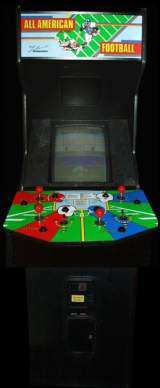 | All American Football Leland (1989) | Allows players to select from a list of "college" teams in addition to "pro" teams representing the 26 cities/regions which had NFL teams at the time. It is also the only game in the series to allow users to purchase power-up items such as "beef" (for boosting the offensive line) and "go juice" (for a second wind on long gains) from a "sideline shop" during the game. The game did not have licenses from the NFL, NFLPA or the NCAA. Because of this, pro teams were only referred to by city (Green Bay, Pittsburgh, etc.), state (Minnesota) or region (New England). Most of the college teams featured were ones with names that were based geographically (Michigan, Wisconsin, etc.) or militaristic (Army and Navy). This feature was purely cosmetic as the teams all played the same regardless of which one was chosen. It also allowed users to choose their own team colors no matter which team they chose. Like its predecessors, All-American Football involved the use of a "spring stick," which required players to aim passes and kicks, making for more realistic gameplay. | ||
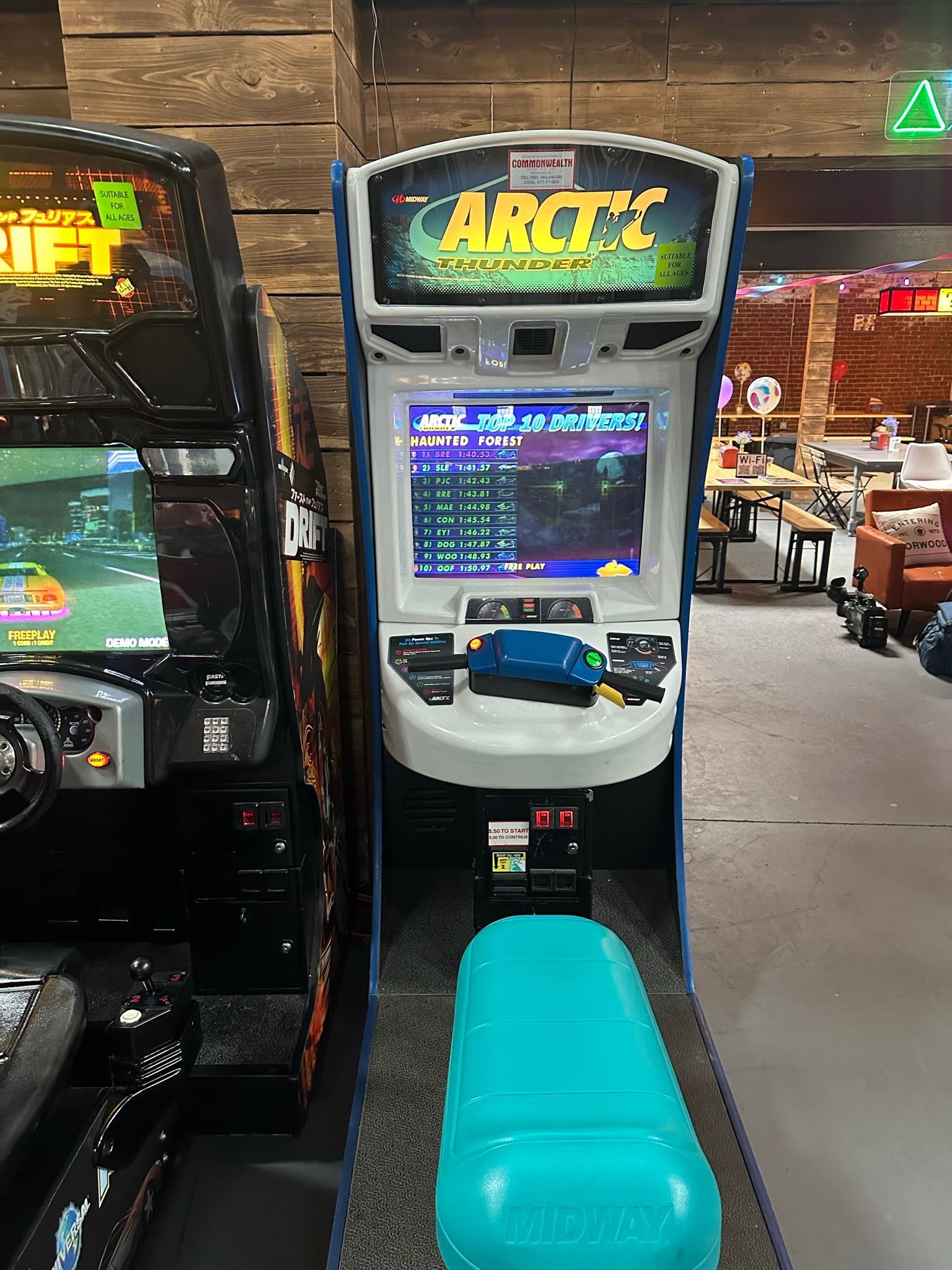 | Arctic Thunder Midway Games (2000) | Arctic Thunder is a snowmobile racing game developed by Midway Games. It was released as an arcade game, as well as on the Sony PlayStation 2 and Xbox consoles, and was a launch title for the latter. In the arcade version of the game, jets blow cold or hot winds, depending on the setting, in the player's face during gameplay. Arctic Thunder is part of Midway's Thunder series, which also included Hydro Thunder, 4 Wheel Thunder, Offroad Thunder, and Hydro Thunder Hurricane. | ||
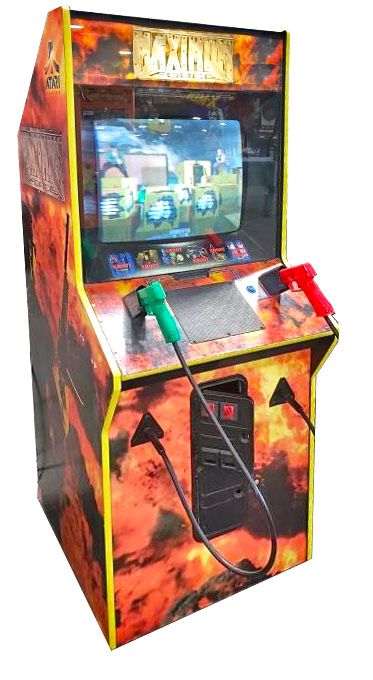 | Area 51 Time Warner Interactive (1995) | Area 51 is a light gun arcade game released by Time Warner Interactive in 1995. It takes its name from the military facility. The plot of the game involves the player taking part in a Strategic Tactical Advanced Alien Response (STAAR) military incursion to prevent aliens, known as the Kronn, and alien-created zombies from taking over the Area 51 military facility. Produced as a last-ditch effort to reverse Atari's struggling fortunes, Area 51 largely underwhelmed critics, who compared it unfavorably to contemporary light gun shooters such as Virtua Cop 2, but was well-liked by players and became a major hit. The game was ported to the PlayStation, Sega Saturn and personal computers. Atari further capitalized on its success with Maximum Force, which used the same arcade board and similar graphics techniques and gameplay, and a direct sequel, Area 51: Site 4. | ||
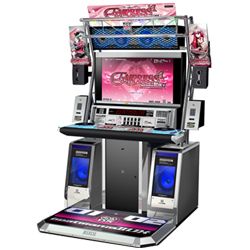 | Beatmania IIDX Konami/Bemani (1999) | Beatmania IIDX (Japanese: ビートマニア ツーディーエックス, Hepburn: Bītomania Tsū Di Ekkusu) (IIDX) is a series of rhythm video games, that was first released by Konami in Japan on 26 February 1999. Beatmania IIDX has since spawned 32 arcade releases and 14 console releases on the Sony PlayStation 2. It is the sequel to the beatmania game series,[4] and is part of the Bemani line of music games. Initially conceived and developed as a sequel to Beatmania, Konami released Beatmania IIDX in Japan in 1999. The development team designed the game to simulate the experience of a DJ performing at a real venue, and gave the cabinet a "club Visual Jockey style."[6] While its predecessor used five keys, IIDX had seven of them, increasing the games complexity and skill ceiling. The larger controller was integrated into the cabinet alongside a larger 40-inch widescreen monitor, dual speakers, and spotlights to replicate the feeling of performing at a live venue. Beatmania IIDX tasks the player with performing songs through a controller consisting of seven buttons and a turntable. Hitting the notes at the correct time increases the score and groove gauge bar, which if equal to or above 80% on Normal difficulty will allow the player to clear the stage. Failing to hit the notes at the correct time depletes the players groove gauge until it is empty.[9] Starting from beatmania IIDX 17 SIRIUS, two new note types are added: Charge Notes, which require the user to hold and release buttons in time with the music, and Backspin Scratches, which involve spinning the turntable in one direction and then turning it in the opposite direction at the end of the note. beatmania IIDX 23 copula introduced a variation called Hell Charge Notes, which refill the gauge when held down but rapidly deplete it when not. Unlike regular Charge Notes, they can be pressed at any time, though missing the start or end will still break the player's combo. Aside from standard single play with seven buttons and a turntable, Beatmania IIDX offers doubles play-style, where users can play with fourteen buttons and two turntables. Certain versions of Beatmania IIDX have modes that are available in both single and double play-styles such as Course mode, Step-up and Arena. In Course mode players are challenged to complete four songs in a row of similar difficulty with a shared health bar, if the health bar reaches zero during any song, the game ends. Step-up mode allows players to play up to four songs without fear of a game-over. However, only a small selections of songs will be available. Arena mode matches up to 4 players in a competitive lobby where each player can pick one song, whichever player performed the best across all 4 songs wins. | ||
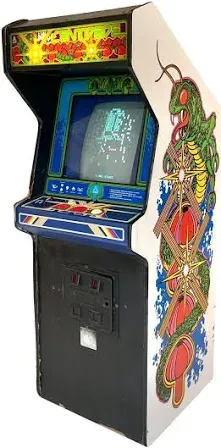 | Centipede Atari (1981) | The player controls the small insect-like creature called the Bug Blaster. It is moved around the bottom area of the screen with a trackball and fires small darts at a segmented centipede advancing from the top of the screen through a field of mushrooms. Each segment of the centipede becomes a mushroom when shot; shooting one of the middle segments splits the centipede into two pieces at that point. Each piece then continues independently on its way down the screen, with the rear piece sprouting its own head. If the centipede head is destroyed, the segment behind it becomes the next head. Shooting the head is worth 100 points while the other segments are 10. The centipede starts at the top of the screen, traveling either left or right. When it touches a mushroom or reaches the edge of the screen, it descends one level and reverses direction. The player can destroy mushrooms (a point each) by shooting them, but each takes four shots to destroy. At higher levels, the screen can become increasingly crowded with mushrooms due to player/enemy actions, causing the centipede to descend more rapidly. | ||
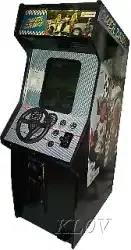 | Chase HQ Taito (1988) | Chase H.Q. is a vehicular combat racing game, originally released as an arcade video game by Taito in 1988. It is sometimes seen as a spiritual successor to Taito's earlier Full Throttle. The player assumes the role of a police officer named Tony Gibson, member of the "Chase Special Investigation Department". Along with his partner, Raymond Broady, he must stop fleeing criminals in high-speed pursuits in a black Porsche 928. Chase H.Q. was ported to many home computers by Ocean Software in 1989, including versions for the ZX Spectrum, Amstrad CPC, Commodore 64, MSX, Amiga and Atari ST. Taito produced versions for the Family Computer (1989), Game Boy (1990), Master System (1990), TurboGrafx-16 (1990), Game Gear (1991), and Saturn (1996). It was released for PlayStation 2 in Japan in 2007 as part of Taito Memories II Volume 2. The game was a commercial success, becoming Japan's highest-grossing dedicated arcade game of 1989 while also becoming a hit overseas for arcades and home systems. The game was also well received by critics. It was followed by three arcade-based sequels: Special Criminal Investigation (1989), Super Chase: Criminal Termination (1992) and Chase H.Q. 2 (2007). Two spin-offs were also released: Crime City (1989) and Quiz H.Q. (1990). | ||
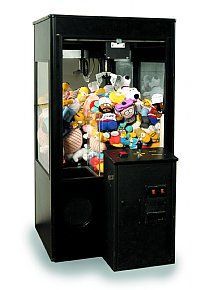 | Claw Machine Pinnacle - ICE (2015) | Set to $3.00 per game. Claw machine is set to "play until you win." So, $3.00 guarantees that you will win a prize. | ||
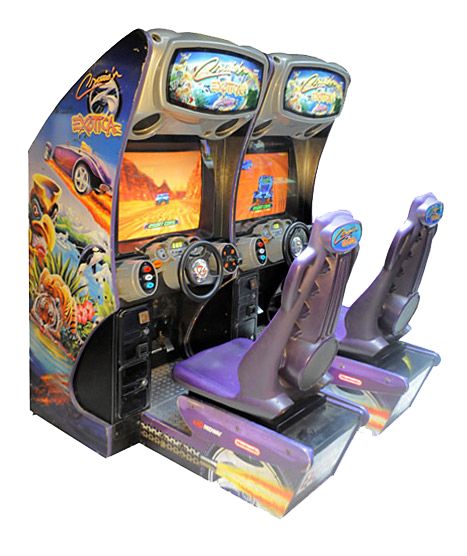 | Cruis'n Exotica (2-Player) Midway (1999) | Manufactured by Midway in 1999, Cruis’n Exotica racing simulator is one of 45 machines under the Cruis’n name that began in 1972. Cruis’n Exotica takes you around several different courses that include a dinosaur course, underwater course as well as an outer space course. There are rusted out Chevy’s to compete against. Cruis’n Exotica Racing Arcade Game are given a selection of 7 cars to choose from, both in automatic and manual transmissions. This is a minimum and maximum 2-player game that is played in an upright standard style. The controls consist of brake and accelerator pedals, steering wheel, and four positions shifter. | ||
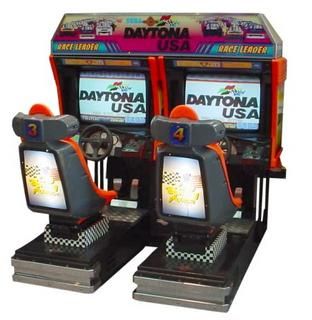 | Daytona USA (2 linked games) Sega (1994) | Daytona USA is a 1994 arcade racing game developed by Sega AM2. Inspired by the popularity of the NASCAR motor racing series in the US, the game has players race stock cars on one of three courses. It was the first game to be released on the Sega Model 2 arcade system board. Released by Sega in March 1994, Daytona USA is one of the highest-grossing arcade games of all time. Sega partnered with GE Aerospace to develop the Model 2, which renders 3D graphics capable of texture filtering and texture mapping. Daytona USA was developed by AM2 after a meeting of the heads of Sega's regional offices to decide on a game to debut the Model 2 hardware. The concept was suggested by Tom Petit, president of Sega's American arcade division, with input from AM2 director Toshihiro Nagoshi, who became the game's director and producer. Sega aimed to outperform Namco's Ridge Racer (1993). The developers researched motorsports extensively; they mapped Daytona International Speedway, and their experience developing Virtua Racing (1992) helped with lighting and camera control. | ||
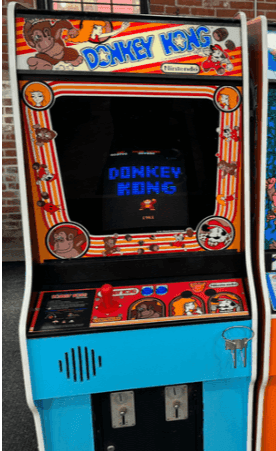 | Donkey Kong Nintendo (1981) | Donkey Kong was one of the earliest platform games, following Mario as he ascends a construction site to rescue Pauline from Donkey Kong. It was released in July 1981 and became Nintendo's first major international success. The windfall of $280 million rescued Nintendo of America from its financial crisis and established it as a prominent brand in America. | ||
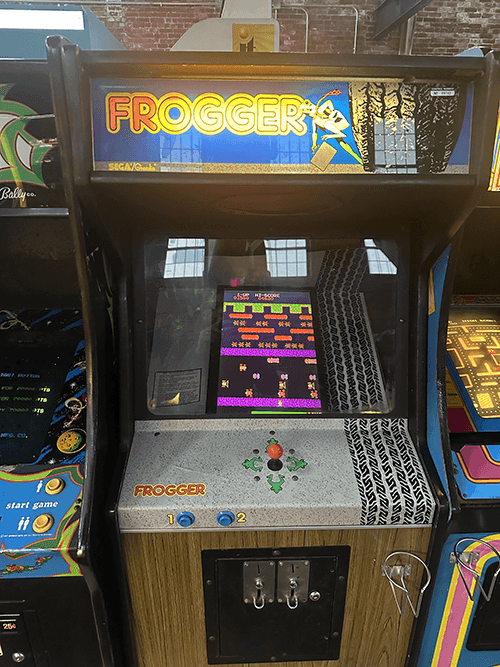 | Frogger Konami/Sega/Gremlin (1981) | Frogger is a 1981 arcade action game developed by Konami and manufactured by Sega. In North America, it was released by Sega/Gremlin. The object of the game is to direct a series of frogs to their homes by crossing a busy road and a hazardous river. Frogger is considered one of the greatest video games ever made. | ||
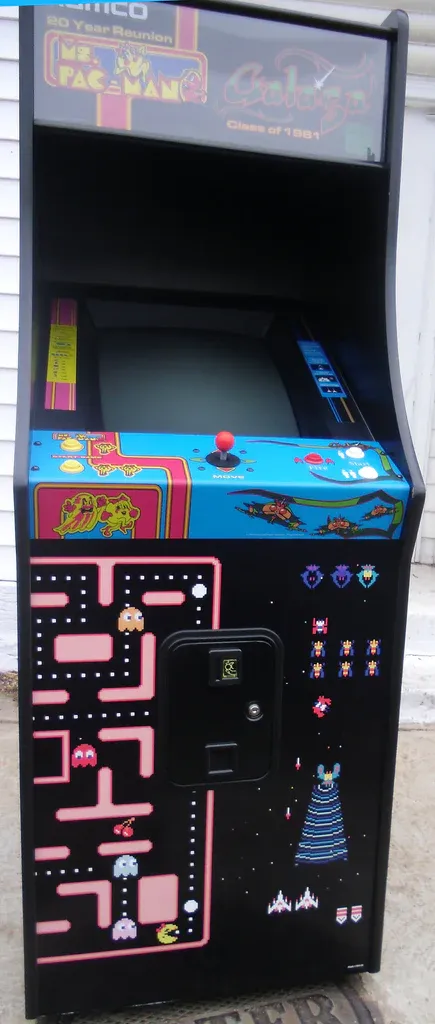 | Galaga Namco/Midway (1981) | Galaga is a 1981 fixed shooter arcade video game developed and published by Namco. In North America, it was released by Midway Manufacturing. It is the sequel to Galaxian (1979), Namco's first major video game hit in arcades. Controlling a starship, the player is tasked with destroying the Galaga forces in each stage while avoiding enemies and projectiles. Some enemies can capture a player's ship via a tractor beam, which can be rescued to transform the player into a "dual fighter" with additional firepower. Shigeru Yokoyama led development with a small team. Initial planning took about two months to finish. Originally developed for the Namco Galaxian arcade board, it was instead shifted to a new system as suggested by Namco's Research and Development division. Inspiration for the dual fighter mechanic was taken from a film that Yokoyama had seen prior to development, where a ship was captured using a large circular beam. The project became immensely popular around the company, with Namco's president Masaya Nakamura even taking interest. | ||
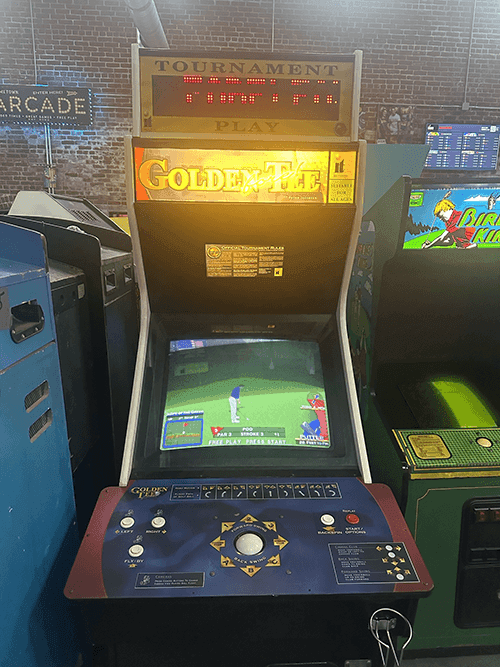 | Golden Tee Incredible Technologies (1995) | Golden Tee Golf is a golf arcade game series by Incredible Technologies. Its signature feature is the use of a trackball to determine the power, direction and curve of the player's golf shot. Play modes include casual 18-hole golf, closest to the pin, and online tournaments. One of the longest running arcade game series, Golden Tee has maintained a large following and spawned a competitive tournament scene. | ||
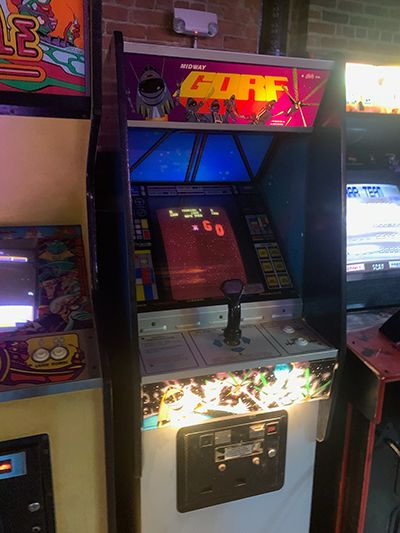 | Gorf Atari (1981) | Gorf is a fixed shooter in which the players take control of an unnamed starship from the Interstellar Space Force with a mission to prevent the Gorfian Empire from conquering Earth. The ship is capable of moving freely in all directions around the lower third of the screen under the control of a joystick. This was a departure from older vertically oriented linear shooters, including Space Invaders and Galaxian, which allowed only horizontal movement of the player's ship controlled by left and right buttons. At the time, the joystick input and two-dimensional movement were still unusual enough that contemporary video game guides noted them as distinctive features of Gorf. | ||
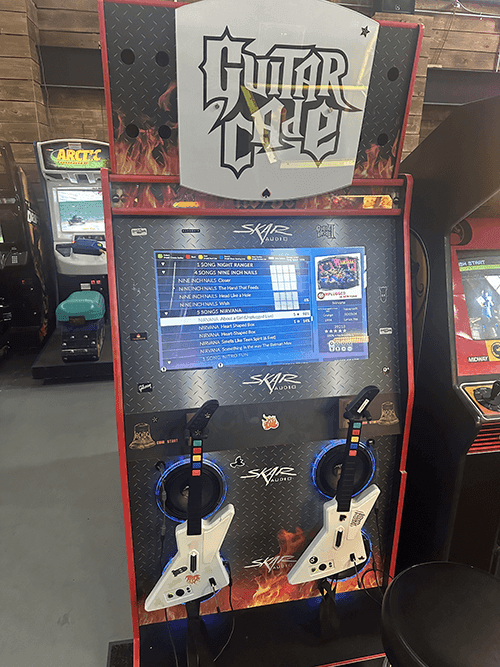 | Guitar Hero (Clone Hero) Srylain Inc. (2017) | Clone Hero is a freeware music rhythm video game created by Ryan Foster, first released in alpha on March 1, 2017, receiving a full release on November 29, 2022. The game is a clone of the Guitar Hero franchise with nearly identical gameplay. The main draw of the game is its ability to play community-made songs, which has resulted in a large fan community around the game as well as a resurgence in popularity for the genre. | ||
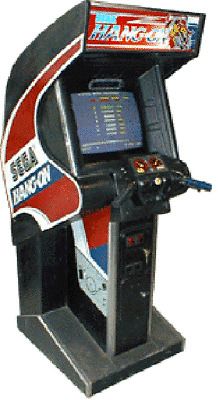 | Hang On Sega (1985) | Hang-On is an arcade racing game released by Sega in 1985 and later ported to the Master System. In the game, the player controls a motorcycle against time and other computer-controlled bikes. It was one of the first arcade games to use 16-bit graphics and uses the Super Scaler arcade system board, created with design input from Yu Suzuki, as technology to simulate 3D effects. The deluxe cabinet version also introduced a motion-controlled arcade cabinet, where the player's body movement on a large motorbike-shaped cabinet corresponds with the player character's movements on screen. Yu Suzuki began development of Hang-On after deciding to design a motorcycle racing game as a way to use a torsion bar in an arcade game. With market research suggesting GP 500 racing was popular, Suzuki took inspiration from world champion Freddie Spencer and his style of racing. The game's soundtrack was written by Hiroshi Kawaguchi, who used rock music that was uncommon in arcade games at the time. | ||
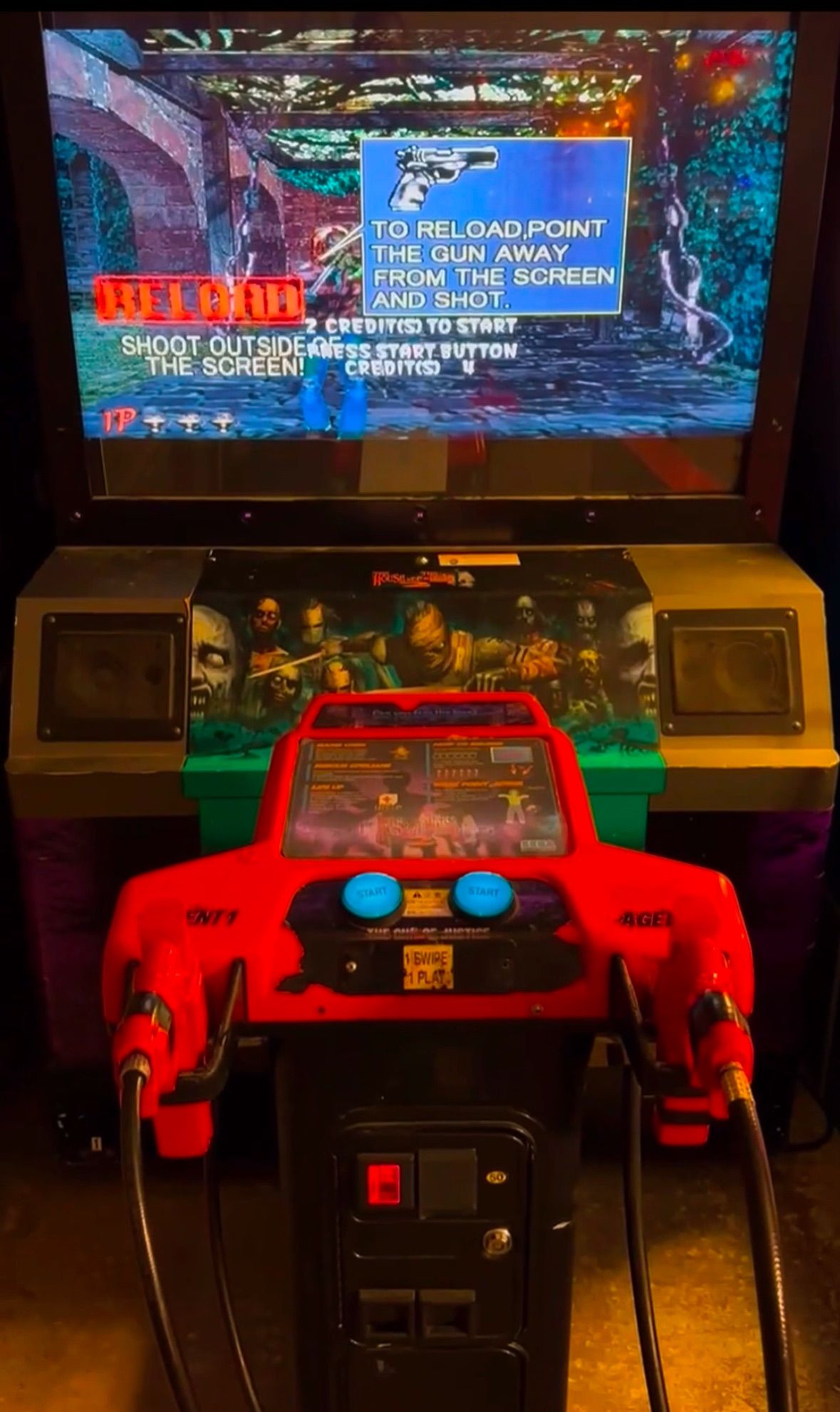 | House of the Dead 2 Sega (1998) | The House of the Dead 2 is a rail shooter light gun game. It includes an auto-reload feature that allows players to point their guns off-screen to reload their weapons without pulling the trigger. Players must shoot their way through hordes of zombies and other monsters while attempting to rescue civilians being attacked. Health is represented by torches at the bottom of the screen and are lost when the play is hit by an enemy or shoots a civilian. Bonus health can be awarded by rescuing civilians and finding first aid kits hidden in crates and barrels. As in the first game, this game incorporates a branching path system that allows for a variety of different routes in each stage depending on the players actions. This is expanded upon with more paths than the original which also lead a greater variety of stage layouts and locations, although the general story itself will always remain the same. The flashbacks to the first The House of the Dead in the game's introductory sequence were recorded using the game's engine. | ||
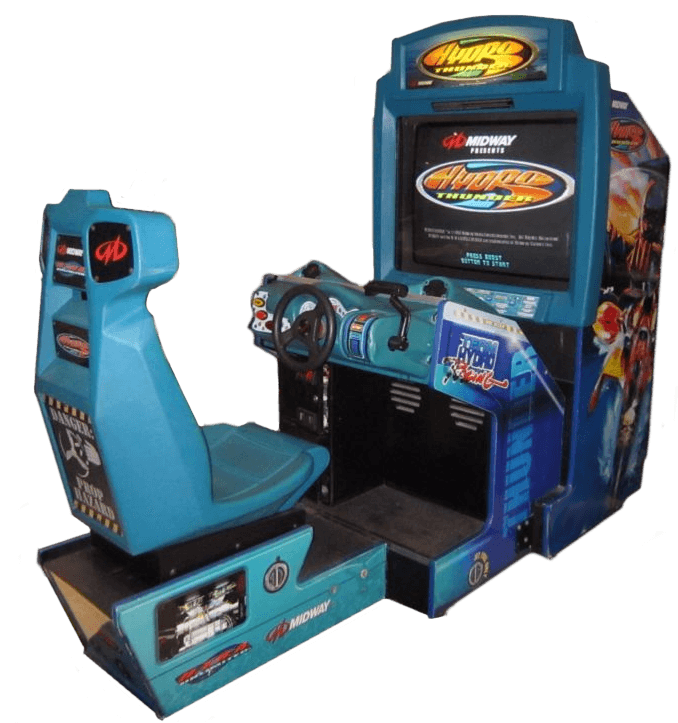 | Hydro Thunder Midway (1999) | Hydro Thunder is an arcade inshore powerboat racing video game originally released by Midway Games in February 1999 and later released for the Sega Dreamcast as a launch title later that year. It was also released for the PlayStation and Nintendo 64 in early 2000. This game is part of Midway's Thunder series of racing games, which includes Offroad Thunder, 4 Wheel Thunder, and Arctic Thunder. Hydro Thunder Hurricane, a sequel to Hydro Thunder, was later released for the Xbox 360 on July 27, 2010 on Xbox Live Arcade. The Dreamcast version received favorable reviews, while the Nintendo 64 and PlayStation versions received mixed or average reviews, according to the review aggregation website GameRankings. Its popularity merited its inclusion on the compilation disc Midway Arcade Treasures 3, which was released in 2005 for the GameCube, PlayStation 2, and Xbox. Arcade version showcasing the boat Banshee racing on the Ship Graveyard track The gameplay of Hydro Thunder is similar to Sega's Daytona USA. It consists of racing high-tech speedboats through treacherous environments, from the cold seas of the Arctic Circle to a post-apocalyptic version of New York City. | ||
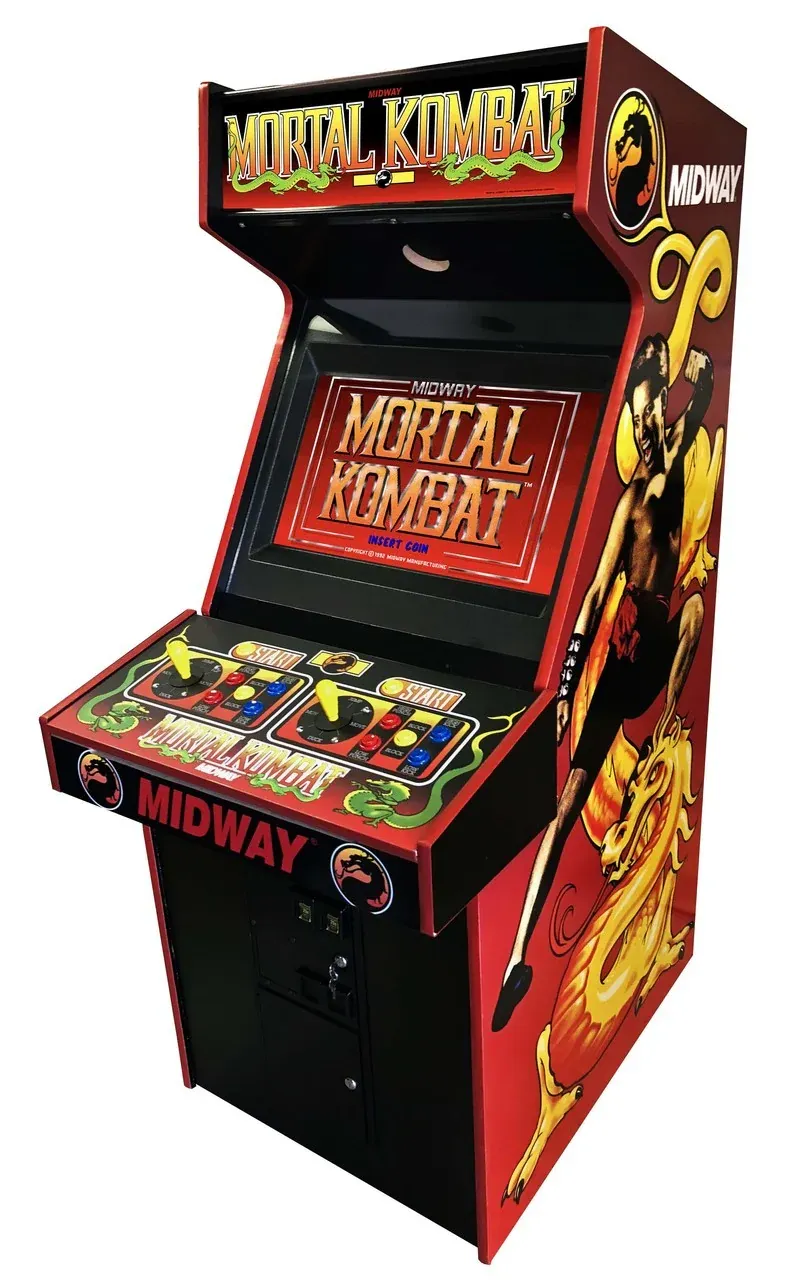 | Mortal Kombat Midway (1992) | Mortal Kombat is an American media franchise centered on a series of fighting video games originally developed by Midway Games in 1992. The original Mortal Kombat arcade game spawned a franchise consisting of action-adventure games, a comic book series, a card game, films, an animated TV series, and a live-action tour. Mortal Kombat has become the best-selling fighting game franchise worldwide and one of the highest-grossing media franchises of all time. The series has a reputation for high levels of graphic violence, including, most notably, its fatalities, which are finishing moves that kill defeated opponents instead of knocking them out. Controversies surrounding Mortal Kombat, in part, led to the creation of the Entertainment Software Rating Board (ESRB) video game rating system. Early games in the series were noted for their realistic digitized sprites and an extensive use of palette swapping to create new characters. Following Midway's bankruptcy, the Mortal Kombat development team was acquired by Warner Bros. Entertainment and re-established as NetherRealm Studios. | ||
 | Ms. PAC-MAN (2 games) Midway (1982) | Ms. Pac-Man is a 1982 maze arcade video game developed by General Computer Corporation and published by Midway. It is a spin-off sequel to Pac-Man (1980) and the first entry in the series to not be made by Namco. Controlling the title character, Pac-Man's wife, the player is tasked with eating all of the pellets in an enclosed maze while avoiding four colored ghosts. Eating the larger "power pellets" lets the player eat the ghosts, which turn blue and flee. General Computer made the game as a modification kit for the original Pac-Man, titled Crazy Otto. However, due to previous legal action with Atari, Inc., GCC was forced to present the project to Midway, the North American and Japanese distributor of Pac-Man. Midway purchased the project and enlisted GCC to use the game as a basis for the sequel to Pac-Man. Multiple names were considered for the game, including Miss Pac-Man and Mrs. Pac-Man, before the final name was chosen for being easier to pronounce. While development had started without Namco's consent, company president Masaya Nakamura was brought in and provided feedback on the player character's design. The company ultimately collected the same royalties on each cabinet as they had with Pac-Man. | ||
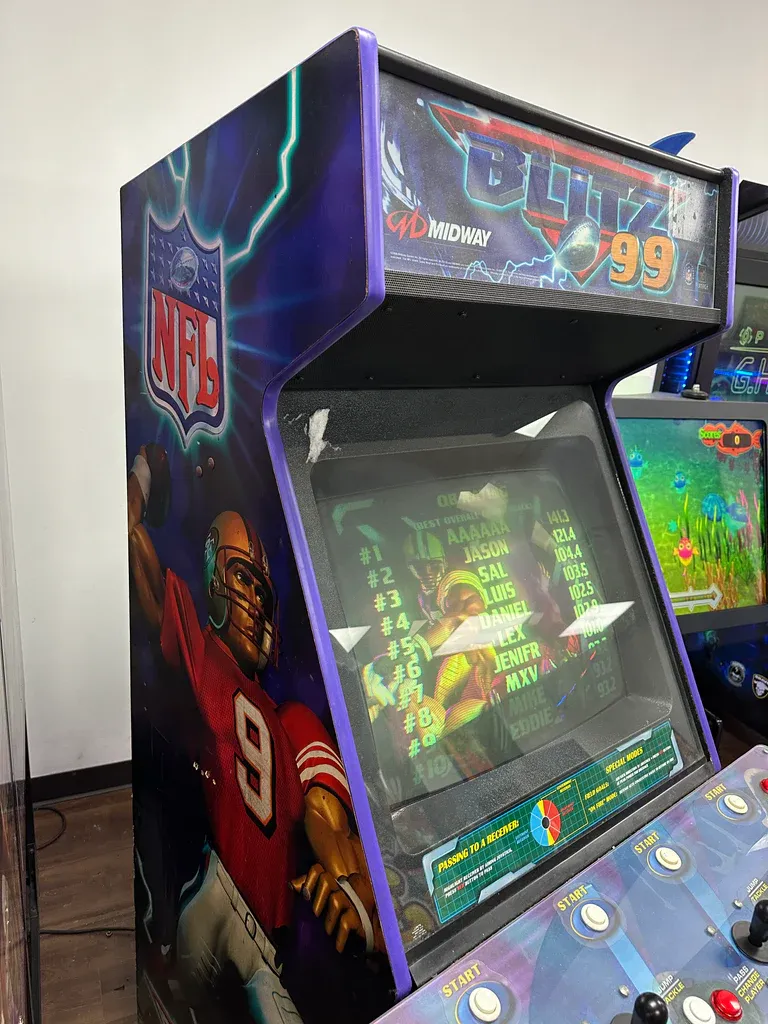 | NFL Blitz Midway (1999) | NFL Blitz '99 was manufactured by Midway Games in 1998. Players choose an official NFL team, each with unique statistics, and compete in American football games with very few real-world rules. The object of the game is to try and win the Superbowl! | ||
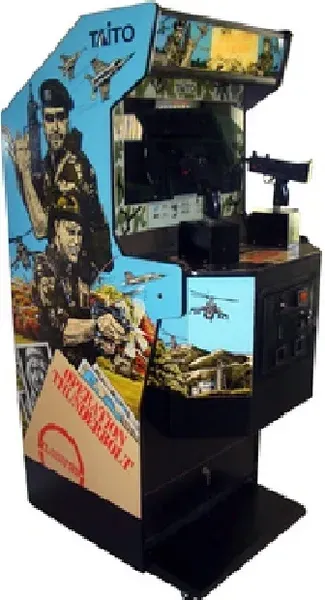 | Operation Thunderbolt Taito (1988) | Operation Thunderbolt is a light gun shooter video game developed by Taito and released for arcades in 1988. As the sequel to Operation Wolf, changes include two-player gameplay with two positional gun controllers mounted on the arcade cabinet, and a new forward-scrolling pseudo-3D perspective combined with side-scrolling sections. The arcade game was a commercial success and was one of the top three highest-grossing dedicated arcade games of 1989 in both Japan and the United States. Versions were released for Amiga, Commodore 64, and Super Nintendo Entertainment System. The arcade exclusive sequel Operation Wolf 3 was released in 1994. Gameplay Green berets Roy Adams and Hardy Jones must save American hostages from a hijacked airliner which was forced to land in the fictional African province, Kalubya. They must capture six different bases, shoot enemies with machine guns or grenade launcher, and try to save the hostages. Enemies include soldiers, jeeps, tanks, and helicopters, attacking with bullets, grenades, or rockets. In stages 4 and 6, killing one of the hostages will decrease the player's life. At least one hostage must be rescued in those stages, or the game is over. In Stage 8, the players must engage with the lead hijacker holding the pilot hostage. Continues are not permitted. If the pilot gets killed, a bad ending will be shown "The pilot is dead; escape is impossible". If the hijacker is killed, the good ending will be shown where the player and hostages flee the hostile nation, with the plane's takeoff. Changes from Operation Wolf include the arcade cabinet using positional gun controllers instead of light gun, two-player simultaneous play with two mounted guns, and a new forward-scrolling pseudo-3D perspective combined with side-scrolling sections. | ||
 | Over Drive Konami (1990) | Over Drive is a racing game produced by Konami in 1990. | ||
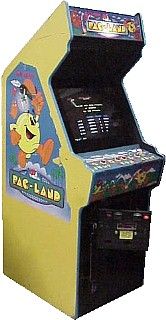 | Pac-Land Namco/Midway (1984) | Pac-Land is a 1984 side-scrolling arcade platform game developed and released by Namco. It was distributed in North America by Bally Midway, and in Europe by Atari Games. Controlling Pac-Man, the player must make it to the end of each stage to return a lost fairy back to its home in Fairyland. Pac-Man will need to avoid obstacles, such as falling logs and water-spewing fire hydrants, alongside his enemies, the Ghost Gang. Eating large flashing Power Pellets will cause the ghosts to turn blue, allowing Pac-Man to eat them for points. Pac-Land was created by Namco Research and Development 1 programmer Yoshihiro Kishimoto, who was tasked with creating an arcade game based on the American Pac-Man cartoon television series by Hanna-Barbera. The backgrounds were made to be vibrant and colorful, and the characters to be detailed and move smoothly to match the show's animation style. The control scheme was inspired by Konami's Track & Field (1983), using buttons instead of a traditional joystick to make it stand out among other games at the time. A new Namco Pac-Land arcade system was created to make it easier to develop the game and was used for several later Namco games, including Baraduke (1985) and Metro-Cross (1985). | ||
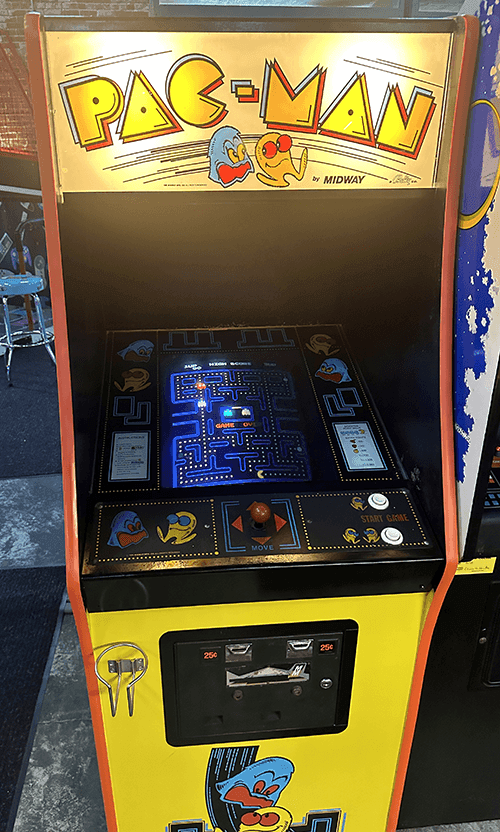 | Pac-Man Namco (1980) | Pac-Man is one of the longest-running, best-selling, and highest-grossing video game franchises in history, and the game has seen regular releases for over 40 years, has sold nearly 48 million copies across all of the platforms, and has grossed over US$14 billion, most of which has been from the original arcade game. The character of Pac-Man is the official mascot of Bandai Namco, and remains one of the most recognizable video game characters in history. The franchise has been seen as important and influential, and is often used as a representation for 1980s popular culture and video games as a whole. | ||
 | POW: Prisoner of War SNK (1988) | P.O.W.: Prisoners of War, is a side-scrolling beat 'em up game produced by SNK and originally released as an arcade game in 1988. The game takes place during the Cold War where the player or players control a duo of military prisoners who break free from their cell to relentlessly fight their way into the main base of their adversaries in order to eliminate their leader and escape with their lives. As a lone wolf, or as partners, the mission objective is to escape from the enemy's base by fighting through four stages filled with numerous types of enemy soldiers trying to impede the player's escape. The stages consist of a POW camp, a warehouse, a jungle, and the enemy's base. Occasionally the enemy will attack the player with vehicles such as an assault chopper, an armored truck or motorcycles. At the end of the final stage, the player confronts an enemy general before being picked up by the extraction chopper proceeding to the final escape sequence. The game can be played by up to two players simultaneously: Player 1 controls a P.O.W. dressed in a navy blue guerilla-warfare uniform named Snake Player 2 controls a palette swap of the same character dressed in a blood red guerilla-warfare uniform who is named Bart The controls consists of an eight-way joystick for moving the character and three action buttons for punching, kicking, and jumping. There are also three special attacks performed by pressing two buttons simultaneously: a jump kick (jump, and then kick), a back punch (jump and punch simultaneously), and a headbutt (punch and kick simultaneously). The player can also pick up one of two weapons dropped by defeated enemies: a throwing knife and a machine gun. The controls changes while wielding a weapon. The knife is thrown by pressing the punch button, but can be preserved by the player until needed by using kicks. When wielding the machine gun, the player can fire it by pressing the kick button or conserve its ammo by pressing the punch button to gun whip enemies | ||
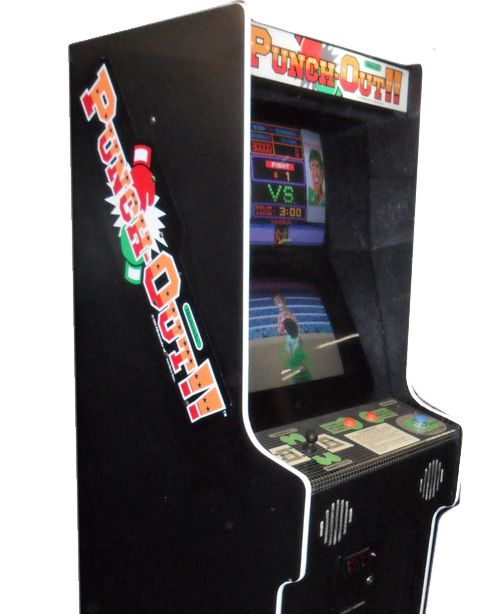 | Punch-Out!! Nintendo (1984) | Punch-Out!! is an 1984 arcade boxing video game by Nintendo. It was the first in a series of Punch-Out!! games. The arcade game was a global commercial success, becoming the top-performing arcade game of 1984 in the United States. It produced an arcade sequel known as Super Punch-Out!!, a spin-off of the series titled Arm Wrestling, a highly popular version for the NES originally known as Mike Tyson's Punch Out!!, and Super Punch-Out!! for the SNES. The arcade game introduced recurring video games characters such as Glass Joe, Piston Hurricane, Bald Bull, and Mr. Sandman. It was also the debut project at Nintendo for composer Koji Kondo, better known for his later contributions in the Super Mario and The Legend of Zelda series. | ||
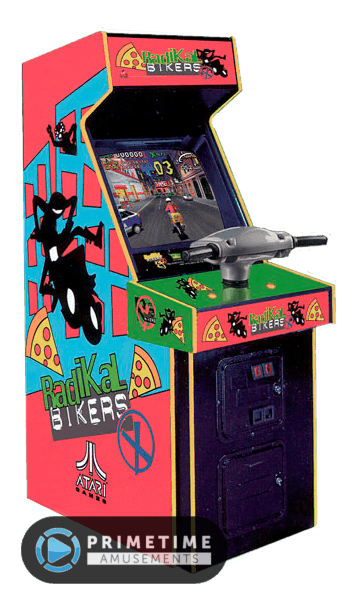 | Radikal Bikers Gaelco (1998) | Radikal Bikers is a racing arcade game developed by the Spanish company Gaelco in 1998. The spiritual successor to this game was Smashing Drive. Radikal Bikers is set in a Mediterranean environment, and is based on delivering pizza on a rare Italian scooter called Italjet Dragster in heavy traffic before your AI opponent does, while getting points. The arcade version has three difficulty levels, which correspond to each of the different places: Margherita (easy, set in Milan), Capricciosa (medium, set in Rome), and Diabola (hard, set in Naples). If you beat all four races in a level, you get to play the next level free. Meanwhile, the PlayStation version includes four more locations on top of the original three as part of the extended Radikal mode: Marinara (set in Venice), Fantasia (set in Paris), Reggiana (set in London) and Americana (set in New York). | ||
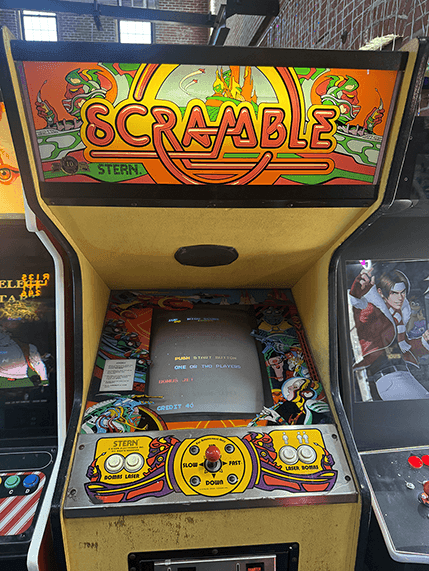 | Scramble Konami/Stern (1981) | Scramble (スクランブル, Sukuranburu) is a horizontally scrolling shooter arcade video game released by Konami in 1981. It was distributed by Stern in North America. It was the first side-scrolling shooter with forced scrolling and multiple distinct levels, and it established the foundation for a new genre. It was Konami's first major worldwide hit. In the United States, it sold 15,136 arcade cabinets within five months and became Stern's second best-selling game. Scramble was not ported to any major contemporary consoles or computers, but there were releases for the Tomy Tutor and Vectrex as well as dedicated tabletop/handheld versions. Unauthorized clones for the VIC-20 and Commodore 64 used the same name as the original. The BBC Micro clone was called Rocket Raid, marketed by Acornsoft from 1982 and primarily within the UK. Scramble's sequel, the more difficult Super Cobra, was released later that year. | ||
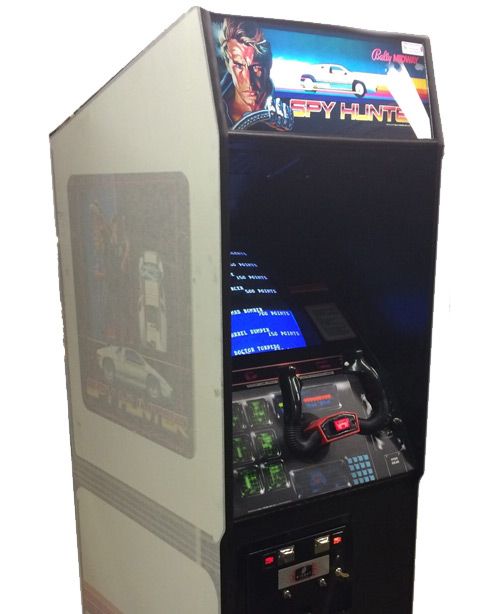 | Spy Hunter Bally Midway (1983) | Spy Hunter is a vehicular combat game developed by Bally Midway and released for arcades in 1983. The game draws inspiration from the James Bond films and was originally supposed to carry the James Bond brand. The object of the game is to drive down roads in the technologically advanced "Interceptor" car and destroy various enemy vehicles with a variety of onboard weapons. Spy Hunter was produced in both sit-down and standard upright versions with the latter being more common.[8] The game's controls consist of a steering wheel in the form of a futuristic aircraft-style yoke with several special-purpose buttons, a two-position stick shift (offering 'low' and 'high' gears), and a pedal used for acceleration. Spy Hunter was a commercial success in American arcades, where it was one of the top five highest-grossing arcade games of 1984 and 1985. It was ported to the Atari 2600, Atari 8-bit computers, Amstrad CPC, ZX Spectrum, Commodore 64, Apple II, ColecoVision, MS-DOS, Nintendo Entertainment System, and BBC Micro. Spy Hunter was followed by Spy Hunter II, which added a 3D view and two-player split-screen play, a pinball tie-in, and a successor series of games bearing the Spy Hunter name. In addition, the NES received a sequel titled Super Spy Hunter. | ||
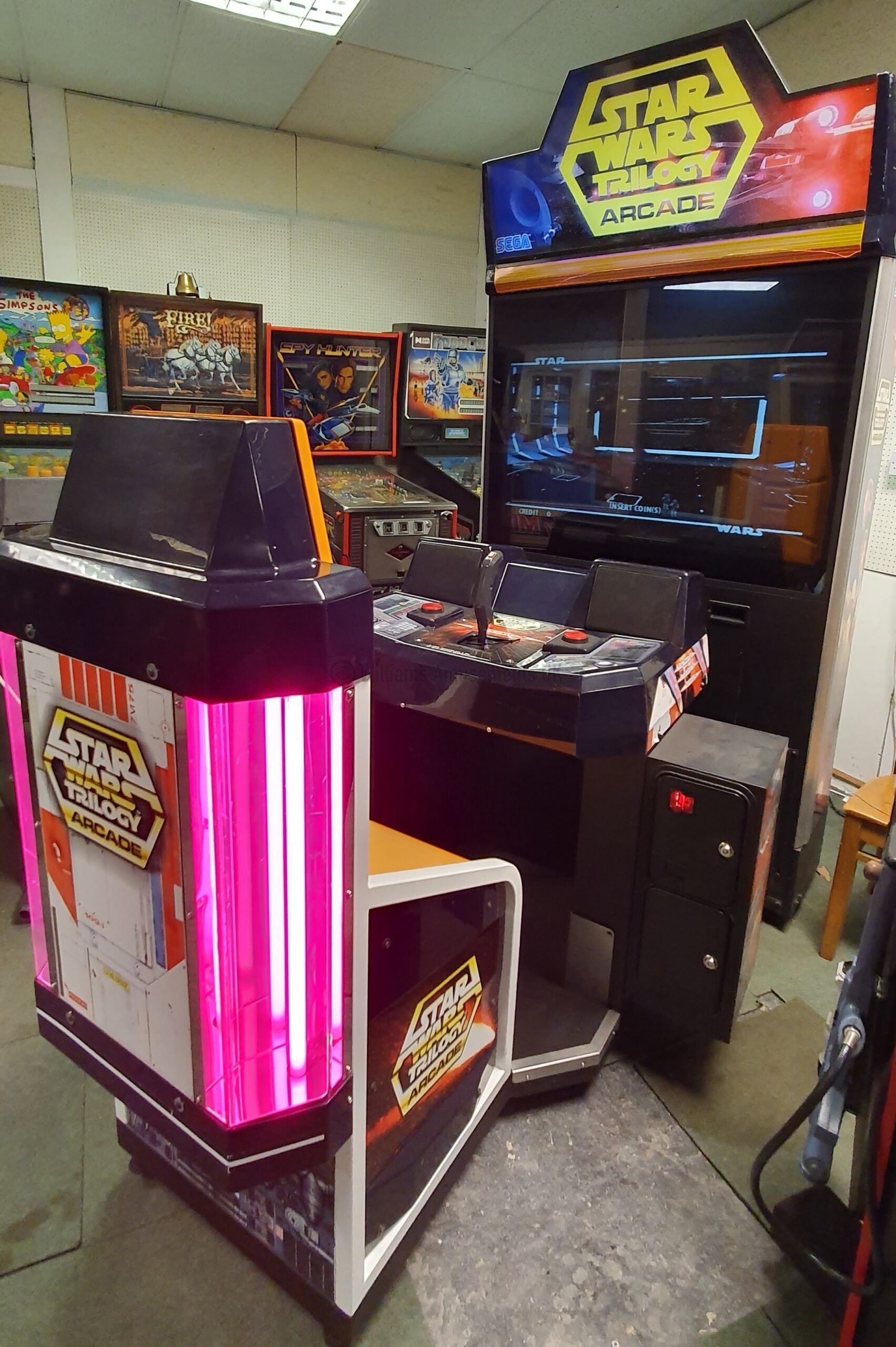 | Star Wars Trilogy Sega (1998) | Sega Star Wars Trilogy Arcade Machine, sit down deluxe version, first released in 1998, is a 3-D rail shooter based on the original trilogy of Star Wars films, released alongside the special editions of these films. Gameplay involves the player moving a crosshair around the screen using a joystick and pressing the fire button on top of the joystick to shoot. A “special event” button lights at certain points of the game and when pressed, triggers an event to happen onscreen. The game puts the player in several key battles of the Star Wars films with one mission for each original Star Wars film. The game combines flight in several different vehicle types, first-person shooting, and a unique lightsaber mode. It uses several pieces of the original film scores, with some dialogue from the films, but most of it is re-recorded with impersonations of the original voices. | ||
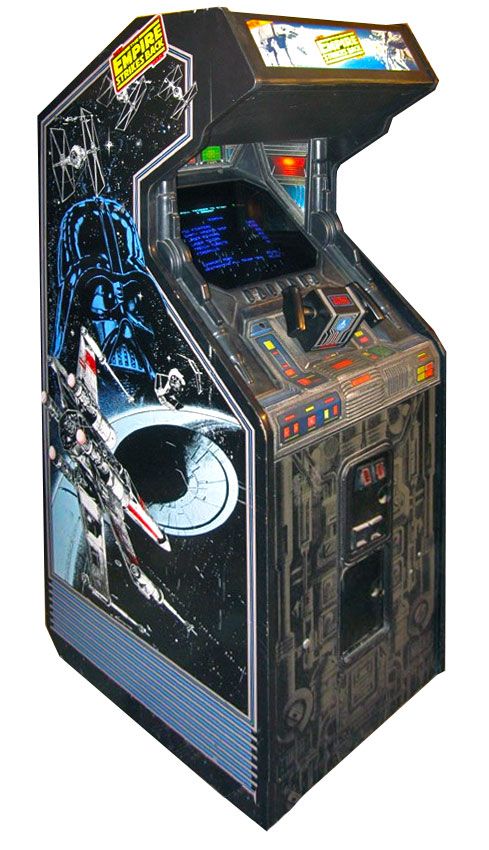 | Star Wars: The Empire Strikes Back Atari (1983) | Star Wars: The Empire Strikes Back is the sequel to the vector graphics Star Wars arcade video game released by Atari, Inc. in 1983. It was made available by Atari Games in 1985 as a conversion kit for the original game. As in Star Wars, the player takes on the role of Luke Skywalker in a set of battle sequences from a first-person perspective. The game features the Battle of Hoth and the subsequent escape of the Millennium Falcon through an asteroid field. It is the third Star Wars arcade title from Atari; the raster game Return of the Jedi came out the previous year. During the Hoth sequences, the player is flying a Rebel snowspeeder. The first section has the player patrolling in a search and destroy mission for Probots (Imperial Probe Droids). Imperial transmissions emanating from the Probots can be shot to prolong the stage. Once the transmission is completed, the player advances. To earn a Jedi letter, the player must eradicate the specified number of probots. The second snowspeeder sequence involves the assault of AT-AT and AT-ST walkers against the Rebel shield generator. The walkers have to be either destroyed or avoided, as collisions will damage the aircraft. The player has four tow-cables which can be used to take down the AT-AT walkers instantly if fired at the walker's legs. Otherwise, the player has to aim for the red cockpits in order to destroy the walkers. To earn a Jedi letter, the player must eradicate the specified number of walkers. | ||
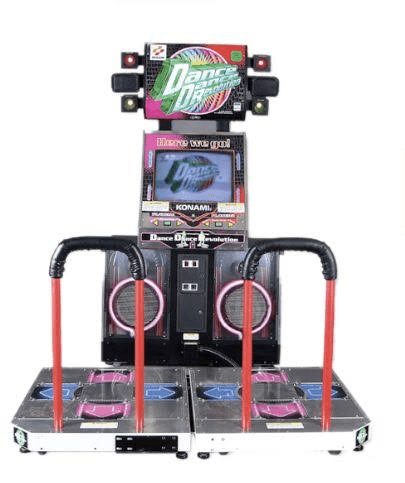 | StepMania (Dance Dance Revolution Cabinet Upgrade) Konami/MIT (2006) | StepMania is a cross-platform rhythm video game and engine. It was originally developed as a clone of Konami's arcade game series Dance Dance Revolution, and has since evolved into an extensible rhythm game engine capable of supporting a variety of rhythm-based game types. Released under the MIT License, StepMania is open-source free software. Several video game series use StepMania as their game engines. This includes In the Groove, Pump It Up Pro, Pump It Up Infinity, and StepManiaX. StepMania was included in a video game exhibition at New York's Museum of the Moving Image in 2005. StepMania was originally developed as an open-source clone of Konami's arcade game series Dance Dance Revolution (DDR). During the first three major versions, the Interface was based heavily on DDR's. New versions were released relatively quickly at first, culminating in version 3.9 in 2005. In 2010, after almost 5 years of work without a stable release, StepMania creator Chris Danford forked a 2006 build of StepMania, paused development on the bleeding edge branch, and labeled the new branch StepMania 4 beta. A separate development team called the Spinal Shark Collective forked the bleeding-edge branch and continued work on it, branding it sm-ssc. On 30 May 2011, sm-ssc gained official status and was renamed StepMania 5.0. Development on the upcoming version, 5.1, has gone cold over the past few years after a couple of betas were released over at GitHub.[7] Project OutFox (formerly known as StepMania 5.3, initially labeled as FoxMania) is a currently closed-source fork of the 5.0 and 5.1 codebase originally planned to reintegrate in StepMania, however further in development, it was decided to become an independent project due to its larger scope of goals while still sharing codebase improvements to future versions of StepMania. These improvements include modernizing the original codebase to improve performance and graphical fidelity, refurbishing aspects of the engine that have been neglected, and to improve and expand its support for other game types and styles. | ||
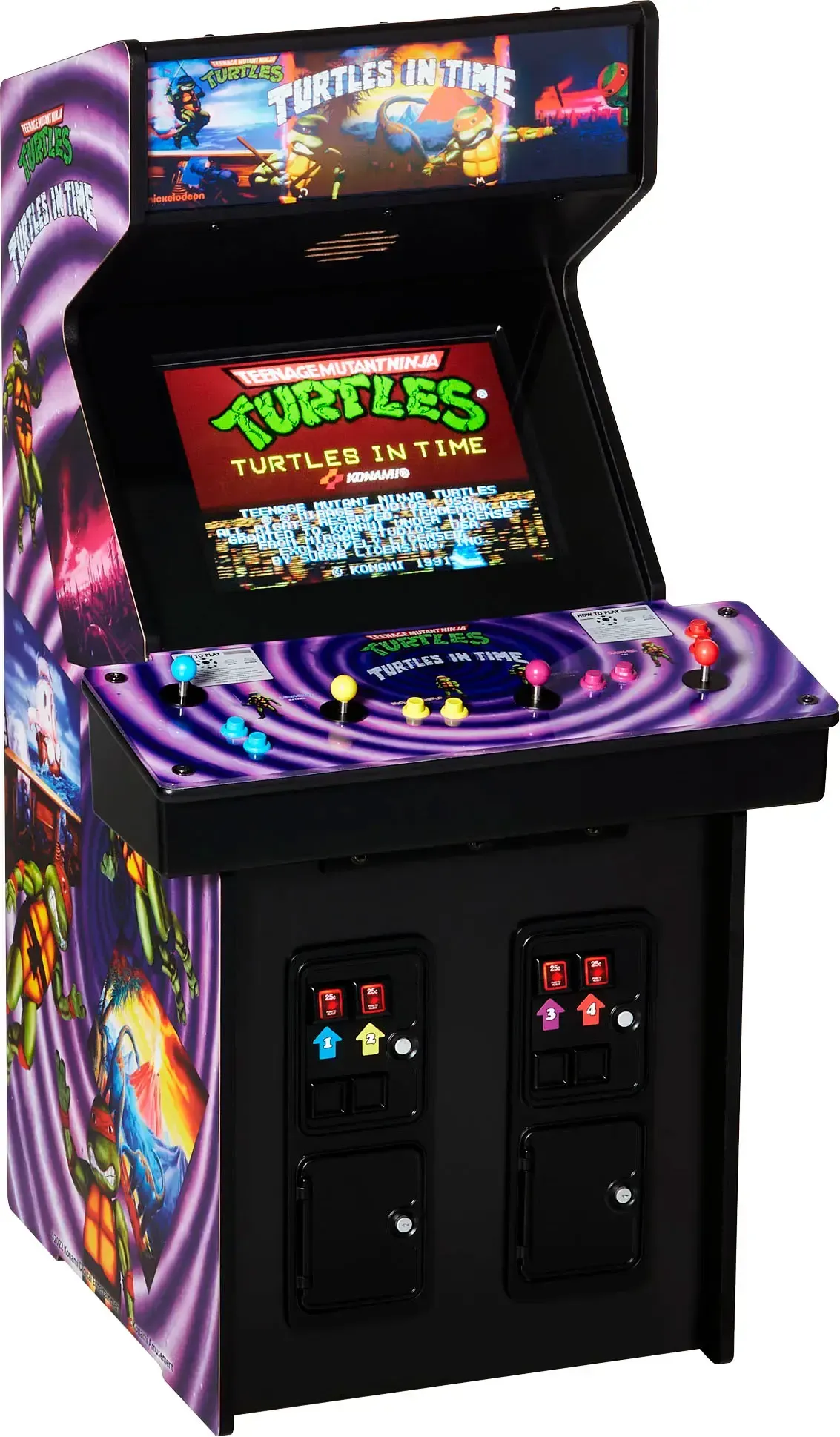 | Teenage Mutant Ninja Turtles: Turtles in Time Konami (1991) | Teenage Mutant Ninja Turtles: Turtles in Time, released as Teenage Mutant Hero Turtles: Turtles in Time in Europe, is a 1991 beat 'em up game developed and published by Konami for arcades. A sequel to the original Teenage Mutant Ninja Turtles arcade game, it is a side-scrolling game based mainly on the 1987 TMNT animated series. Originally an arcade game, Turtles in Time was ported to the Super Nintendo Entertainment System in 1992 under the title Teenage Mutant Ninja Turtles IV: Turtles in Time, continuing the numbering from the earlier Turtles games released on the original NES. That same year, a game that borrowed many elements, Teenage Mutant Ninja Turtles: The Hyperstone Heist, was released for the Sega Genesis. In 2005, the arcade version of Turtles in Time was rereleased on newer consoles. A slightly altered version of the arcade game was included as an unlockable bonus in the 2005 game Teenage Mutant Ninja Turtles 3: Mutant Nightmare. On August 5, 2009, Ubisoft released a 3D remake of the game, Teenage Mutant Ninja Turtles: Turtles in Time Re-Shelled, available as a download for Xbox 360 via Xbox Live Arcade. A downloadable PlayStation 3 version was later released via PlayStation Network on September 10, 2009. | ||
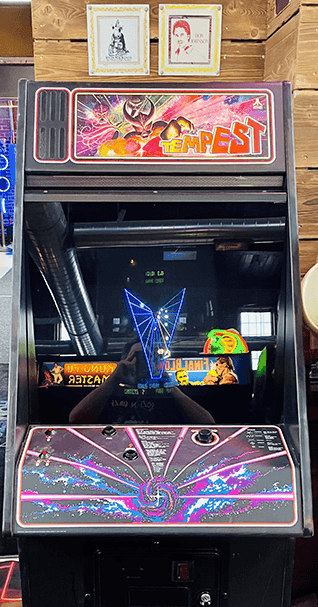 | Tempest Atari (1981) | Tempest is a 1981 arcade game by Atari Inc., designed and programmed by Dave Theurer. It takes place on a three-dimensional surface divided into lanes, sometimes as a closed tube, and viewed from one end. The player controls a claw-shaped "blaster" that sits on the edge of the surface, snapping from segment to segment as a rotary knob is turned, and can fire blaster shots to destroy enemies and obstacles by pressing a button. Tempest was one of the first games to use Atari's Color-QuadraScan vector display technology. It was also the first to let players choose their starting level (a system Atari called "SkillStep"). This feature increases the preferred starting level, which therefore could also be used to allowing the player to continue the previous game if they wished. Tempest was one of the first video games with a progressive level design where the levels themselves varied rather than giving the player the same layout with increasing difficulty. | ||
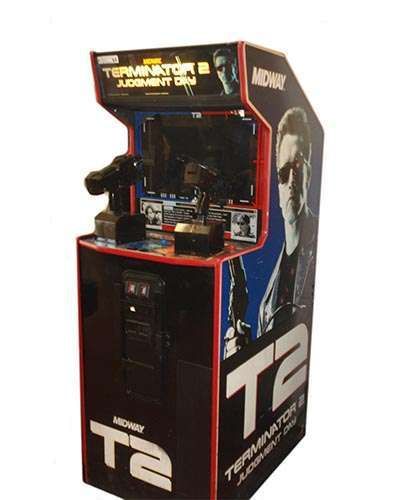 | Terminator 2: Judgment Day Midway (1991) | Use the gun to shoot endoskeletons, Hunter Killers, orbs and other enemies. Gradually, the gun overheats, so a constant supply of coolant (found in crates) is required. Occasionally, extra energy, super shots, super missiles and armor can be found. Also, killing humans is strictly forbidden, and if any are killed, points are deducted from your score at the end of a level. This is still one of the best shooter games of all time. | ||
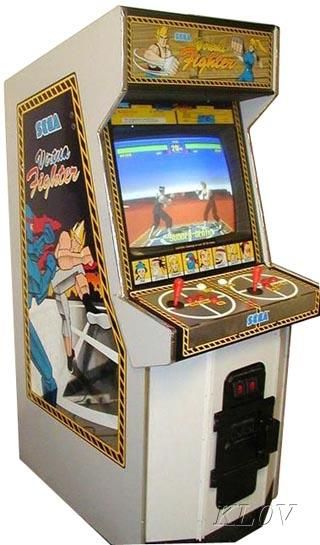 | Virtua Fighter Sega (1993) | Virtua Fighter is a fighting game created for the Sega Model 1 arcade platform by AM2, a development group within Sega, headed by Yu Suzuki. An early prototype version was location tested in Japan by August 1993, before the complete game was released worldwide in December 1993. It was the first arcade fighting game to feature fully 3D polygon graphics. The game was ported to Sega Saturn as a global launch title in 1994 and 1995, and also received a port to the Sega 32X. The game was critically acclaimed and a major hit, becoming one of Sega's best-selling arcade games of all time with more than 40,000 arcade units sold while the Saturn versions sold over 1 million copies. Virtua Fighter was highly regarded for its in-depth 3D fighting engine and real-world fighting techniques, and has been revolutionary and highly influential in the evolution of the genre and video games in general.[5][6] Its success led to the Virtua Fighter series, with its sequel Virtua Fighter 2 coming in 1994. | ||
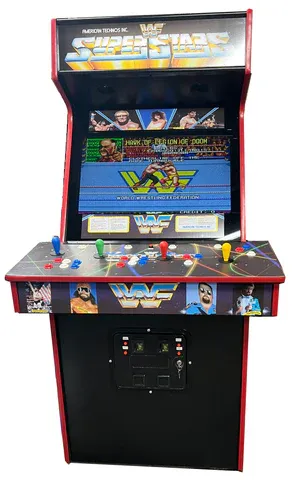 | WWF Wrestlefest Technos (1991) | WWF WrestleFest is a professional wrestling video game developed and released by Technos Japan for arcades in 1991, featuring stars of the World Wrestling Federation (WWF). The game was distributed by Technos in Japan and North America, and by Tecmo in Japan, Europe and Australasia. It is the sequel to Technos' previous WWF game, WWF Superstars. Compared to Superstars, WrestleFest adds a variety of different wrestlers to the roster as well as enhanced graphics and sound. There are more voice samples, including commentary and pre-match introductions by WWF ring announcer Mike McGuirk. The voiced cut scenes featuring Gene Okerlund from Superstars returned as well. | ||
| Pinball | ||||
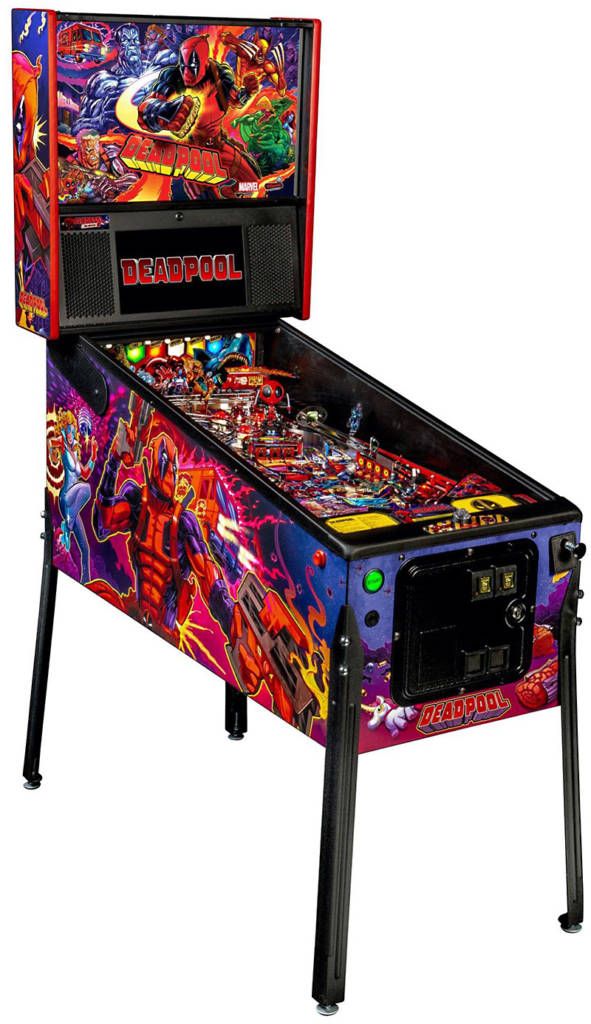 | Deadpool Pro Stern (2018) | Deadpool is a pinball machine designed by George Gomez and released by Stern Pinball in August 2018 based on the comic books of the same name. Nolan North provided voicework as the voice of Deadpool.[1] Brian Huskey provided the voice of Lil' Deadpool and Jennifer Lafleur provided the voice of Dazzler. It is the second pinball table to be based on the character, with the first one being a virtual pinball table from the Marvel Pinball video game, developed by Zen Studios. Like his earlier Ghostbusters design, Zombie Yeti’s cabinet and backbox art is a riot of color, and this carries over onto the playfield. Stern’s Deadpool features stunning and distinctive hand-drawn art by the renowned illustrator. The game features a 3-bank drop target with a ball lock that’s guarding a custom molded Lil’ Deadpool bash toy target. In addition, the machine features two stainless steel and wire form ramps with a Katana Sword ramp return. Deadpool pinball entertains with an amazing array of ninjas, vampires, and chimichangas, making it suitable for all skill levels. The Pro model is themed on Deadpool himself battling a variety of enemies. “Deadpool” is known as the “Merc with a Mouth” because of his talkative nature & is notorious for his outrageously funny offbeat humor which is featured throughout the game. Players will be immersed in the Deadpool universe, teaming up with iconic X-Men characters Wolverine, Dazzler, Domino, and Colossus as they battle against infamous villains Juggernaut, Sabretooth, Mystique, Sauron, and Mr. Sinister. Players will also tag along with Deadpool on his time machine quests as he battles against the T-Rex and the Megalodon. | ||
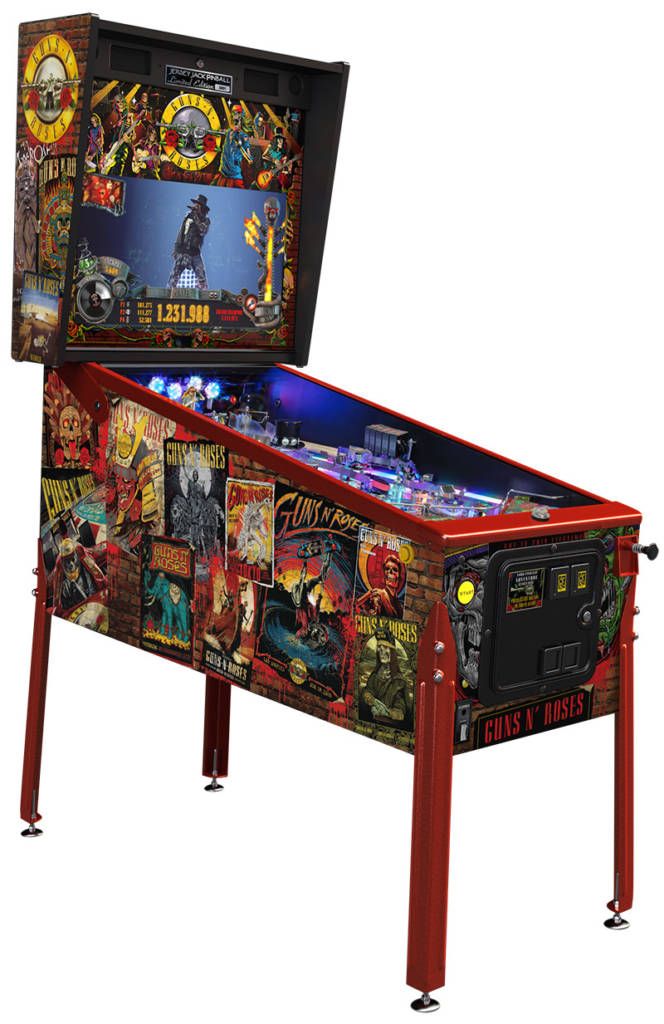 | Guns N' Roses Limited Edition Jersey Jack Pinball (2021) | Rock and roll legends Guns N’ Roses have teamed with Jersey Jack Pinball to design their very own groundbreaking Guns ‘N’ Roses ‘Not In This Lifetime’ pinball game. An avid pinball collector and longtime player, SLASH worked hands-on with Jersey Jack Pinball designer Eric Meunier for over two years, to develop the Guns N’ Roses ‘Not In This Lifetime’ game. As co-designer, SLASH crafted specific game plays and actions, recorded guitar riffs, music, voice, and video for the new game as well as, four unique guitar features for four playable modesin the game. Pinball designer Eric Meunier is widely known as the designer of one of the best-selling pinball games of all time, Pirates of The Caribbean. With the new game offering the greatest rock and roll experience under glass, super-fans will now have a chance to own a piece of highly collectible rock and roll memorabilia. “It’s been a very fulfilling experience working with Jersey Jack on the new GNR Not in This Lifetime pinball machine,” says SLASH. “Jersey Jack pinball games are some of the most unique and beautiful pins ever made and I am honored to have been able to work with their brilliant team to design one of the most original and exciting rock n roll pins ever produced.“ | ||
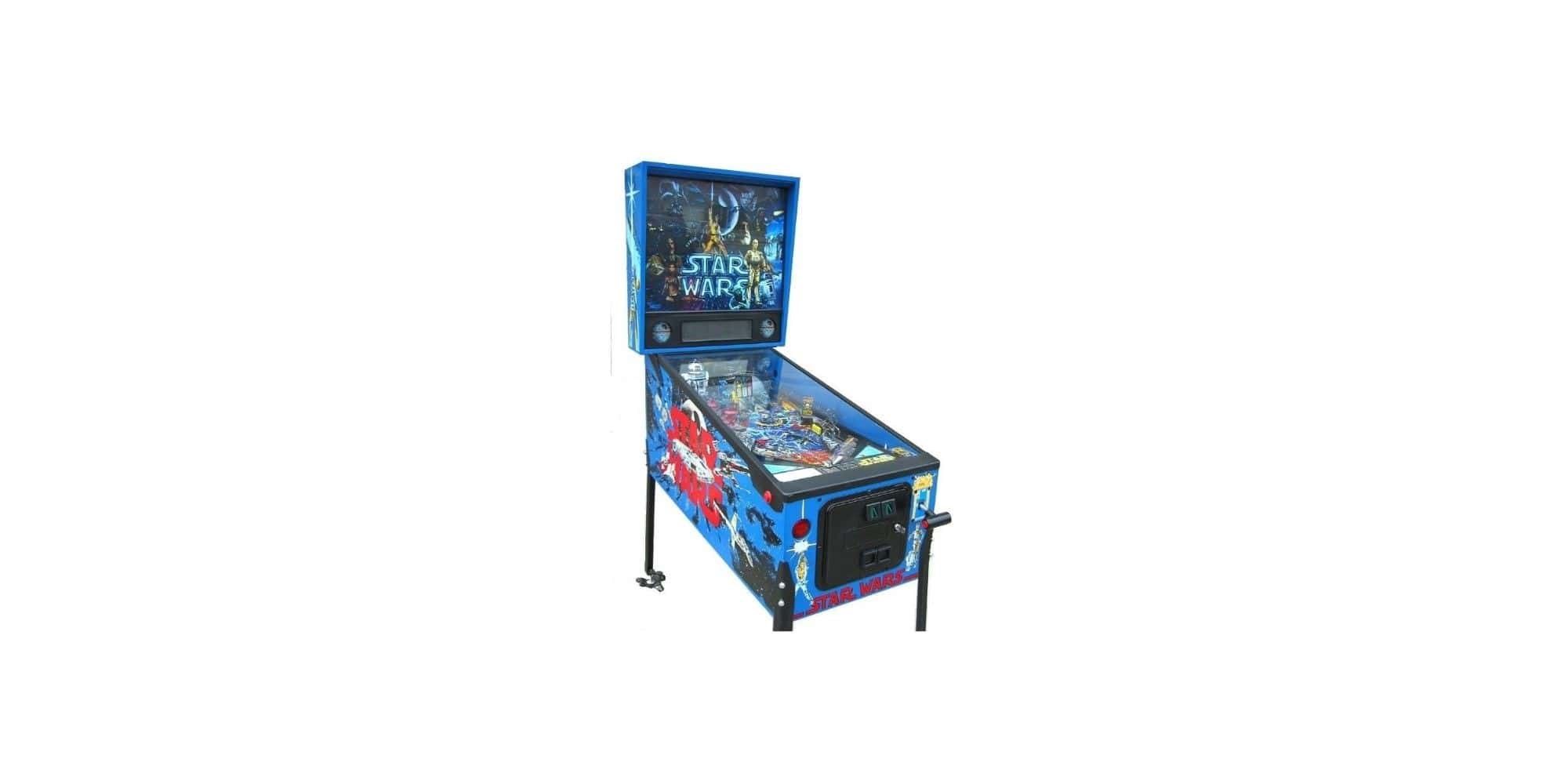 | Star Wars Pinball Data East (1992) | Data East has made some incredible licensed games in their day, and 1992 was a great year for them. Watch R2 hop up and down after you shoot the ball, and just hear all the great sound effects from the original trilogy. The layout is simple, but fun. Nothing feels overly difficult to aim at, and the main ramp is a lot of fun to loop once you figure out how to hit it properly and really rack up that score. The playfield artwork is beautiful, and hearkens back to the old style of the classic comics you'd see back in the day. The backglass is very reminiscent of old movie posters, which, to me, only adds to the appeal of the table. The cabinet art itself is simple, but it really pops. The dark blue and bright red make for a great eye catching cabinet, and you immediately can recognize it from far away. I love the skill shot, too. It's truly unique. Being able to try and "shoot down" the TIE fighters or bombers by launching the ball was a great addition to the table, and having to go back to using the button to shoot Stormtroopers in the middle of gameplay also adds some intense moments to the game! The music is another great addition. While there's some Star Wars originals in there, for the most part, you'll hear some new tunes that Data East made for the table itself, and they're catchy! This one makes for a great addition to anyone's collection, and it has that special charm of the early 90s that only a table like this can truly capture. Sure, the new Stern Star Wars tables are fun, but I can play this Data East table all day and never get tired of shooting that ramp. This feels like a pinball table made by Star Wars fans, for Star Wars fans. DEATH STAR APPROACHING! | ||
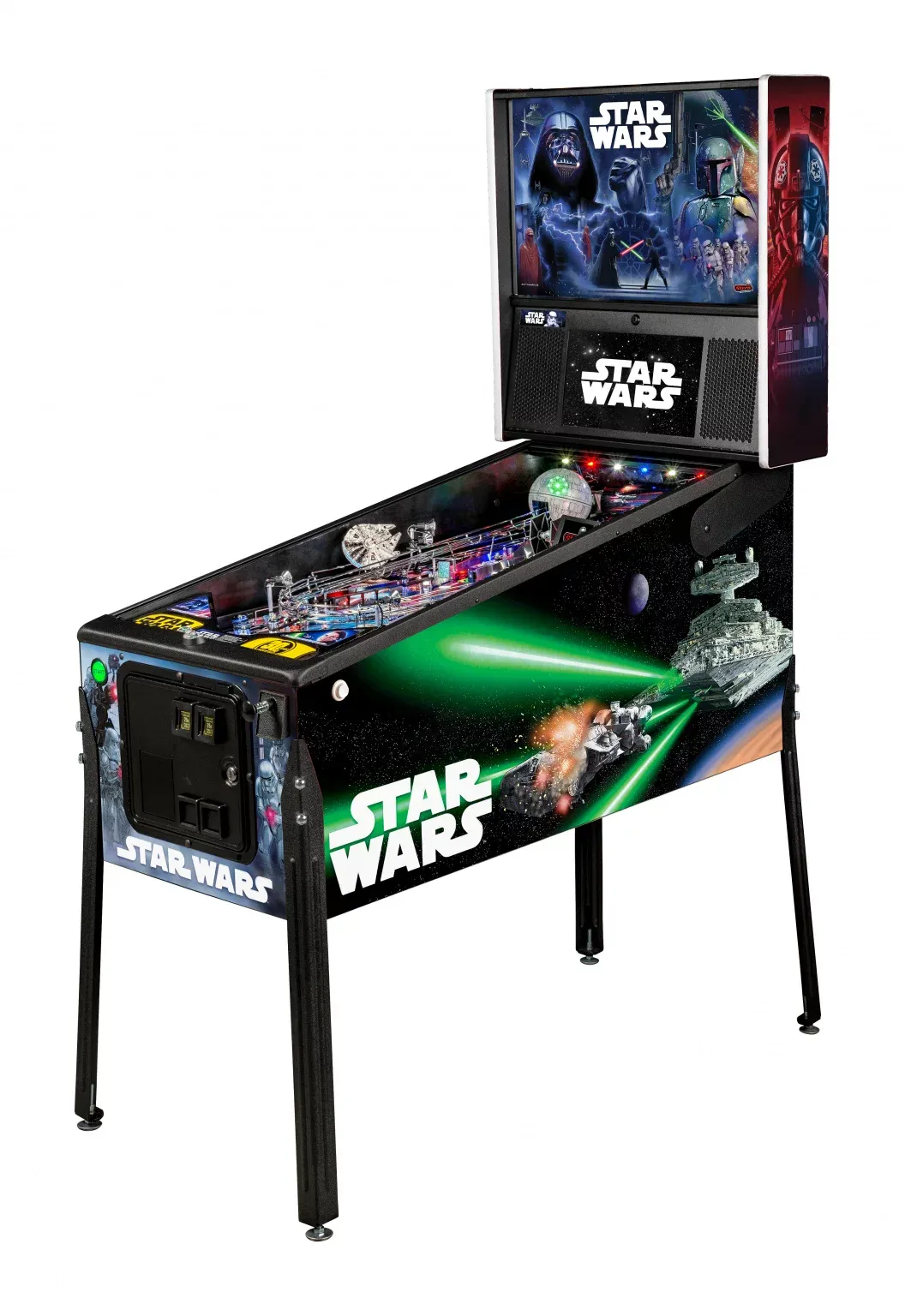 | Star Wars Premium Pinball Stern Pinball (2017) | Star Wars pinball immerses players in the dynamic and challenging Star Wars pinball environment as they battle to restore justice to the Galaxy. Stern’s Star Wars Premium and Limited Edition machines are packed with features that provide an irresistible game experience. The game includes select speech and footage from the original Star Wars trilogy; color-changing LED-lighted inserts; a sculpted LED-lit Millennium Falcon; and a sculpted TIE Fighter. The Premium model also feature two LCD screens, an exploding Death Star interactive display, and a hyperspace ramp. | ||
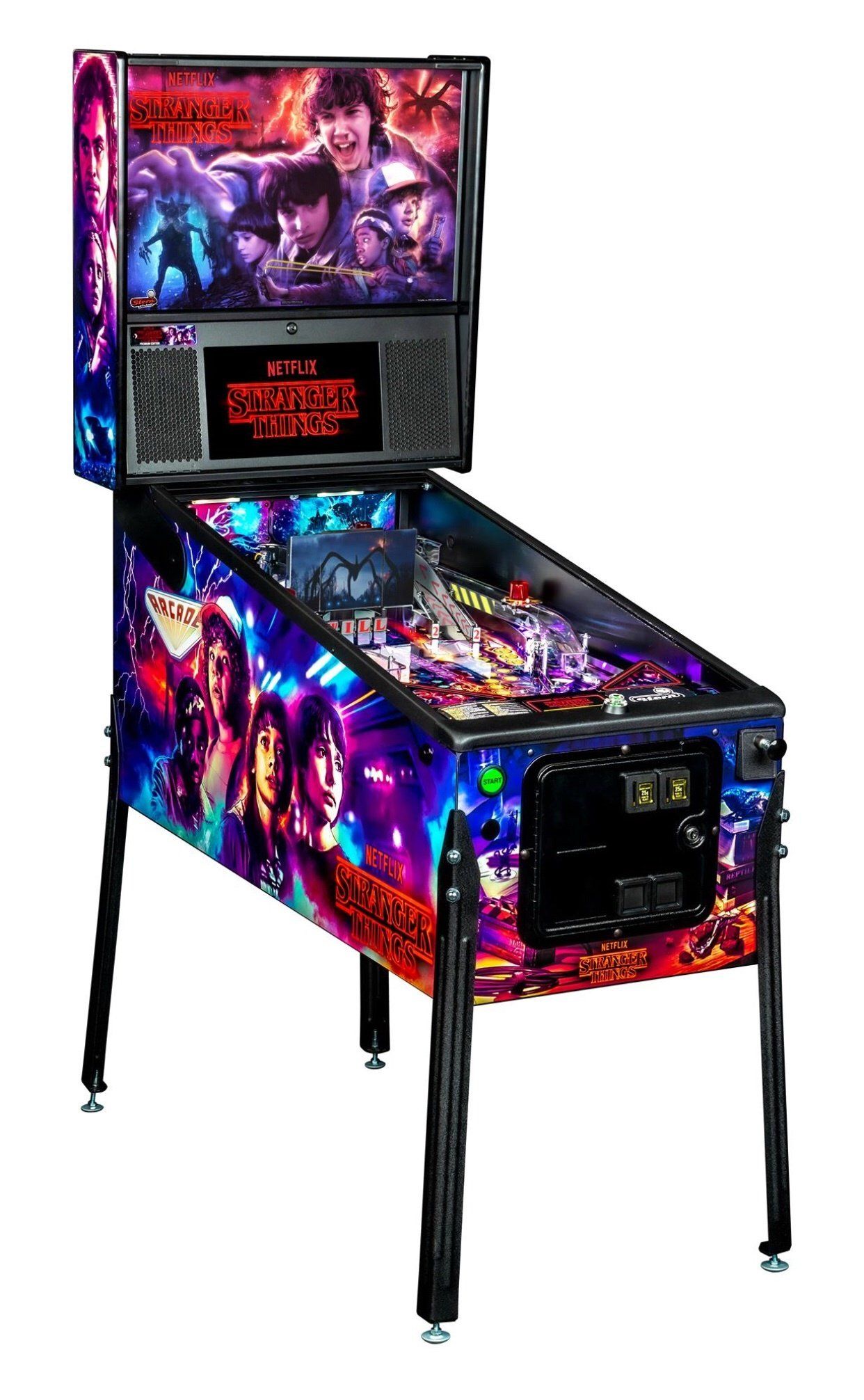 | Stranger Things Premium Stern Pinball (2019) | Experience the terrifying forces in Hawkins, Indiana that turn this small town “upside down” with supernatural elements, strange sightings, and government secrets. Stranger Things pinball machines will immerse players in a search to unravel the extraordinary mysteries and secret government experiments taking place at the Hawkins National Laboratory. The gameplay focuses on unlocking the hidden meanings of supernatural events occurring in and around the town, including the appearance of a girl known as “Eleven” with telekinetic abilities. The ball is wild as Mike, Lucas, Dustin, Will, Joyce, and Police Chief Jim Hopper help Eleven close the dimensional gate. “Stranger Things is one of the most successful shows of all time, connecting with people around the world and across generations. This game features action, mystery, suspense, and humor; Stranger Things is a perfect fit for pinball,” said Gary Stern, Chairman and CEO of Stern Pinball, Inc. The Premium model features a first ever video projector that displays images and animations directly on the playfield, creating dramatic interactions with gameplay action. The center of the playfield features a unique ramp that doubles as a screen and leads the player into a direct battle with the Demogorgon. These models also feature a new Eleven themed “telekinetic” magnetic ball lock. The Premium model also features distinct hand-drawn art in addition to the custom sculpted, interactive Demogorgon bash toy, guarded by drop targets and a rotating ramp. All models include two hideout ball scoops, a Demodog spinner, three custom ramps, and game rules that will transport players into the Upside Down. | ||
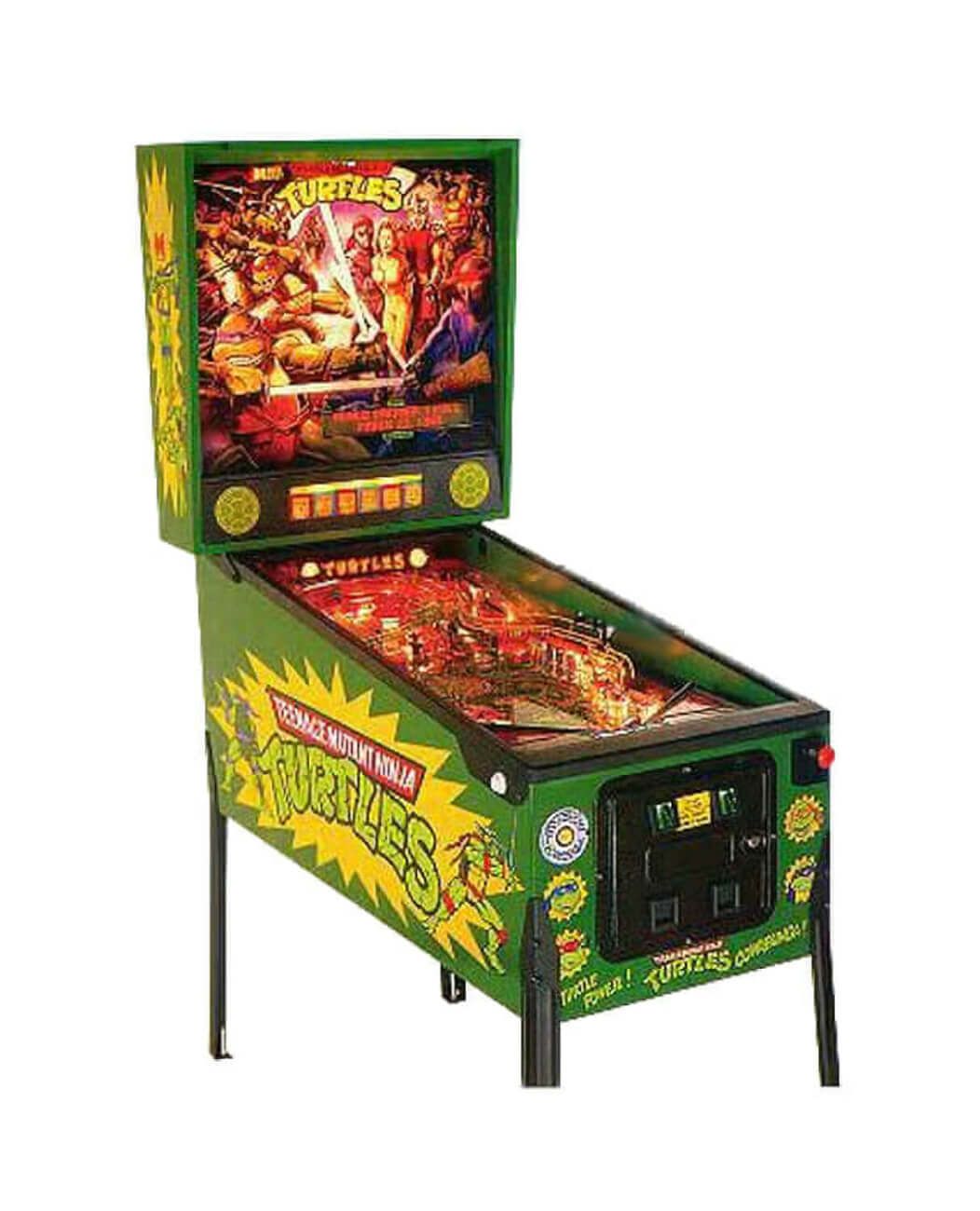 | Teenage Mutant Ninja Turtles Data East (1991) | The Teenage Mutant Ninja Turtles pinball machine by Data East is based on the original comics and film, and was a leader in pinball innovation. The machine features a dot-matrix display, the first disappearing underground pinball shot, and a spinning pizza. Players can earn points by: Bronco-Bustin' Turtle: Raphael climbs on the Bronco Bumper Beat the Clock: Players must master the Twin Skill Shot ramps before time runs out to earn 10 million points Double Pinball Excitement: Players can earn points on the Twin Skill Shot Ramps, which are worth 250,000 points per ball in play | ||
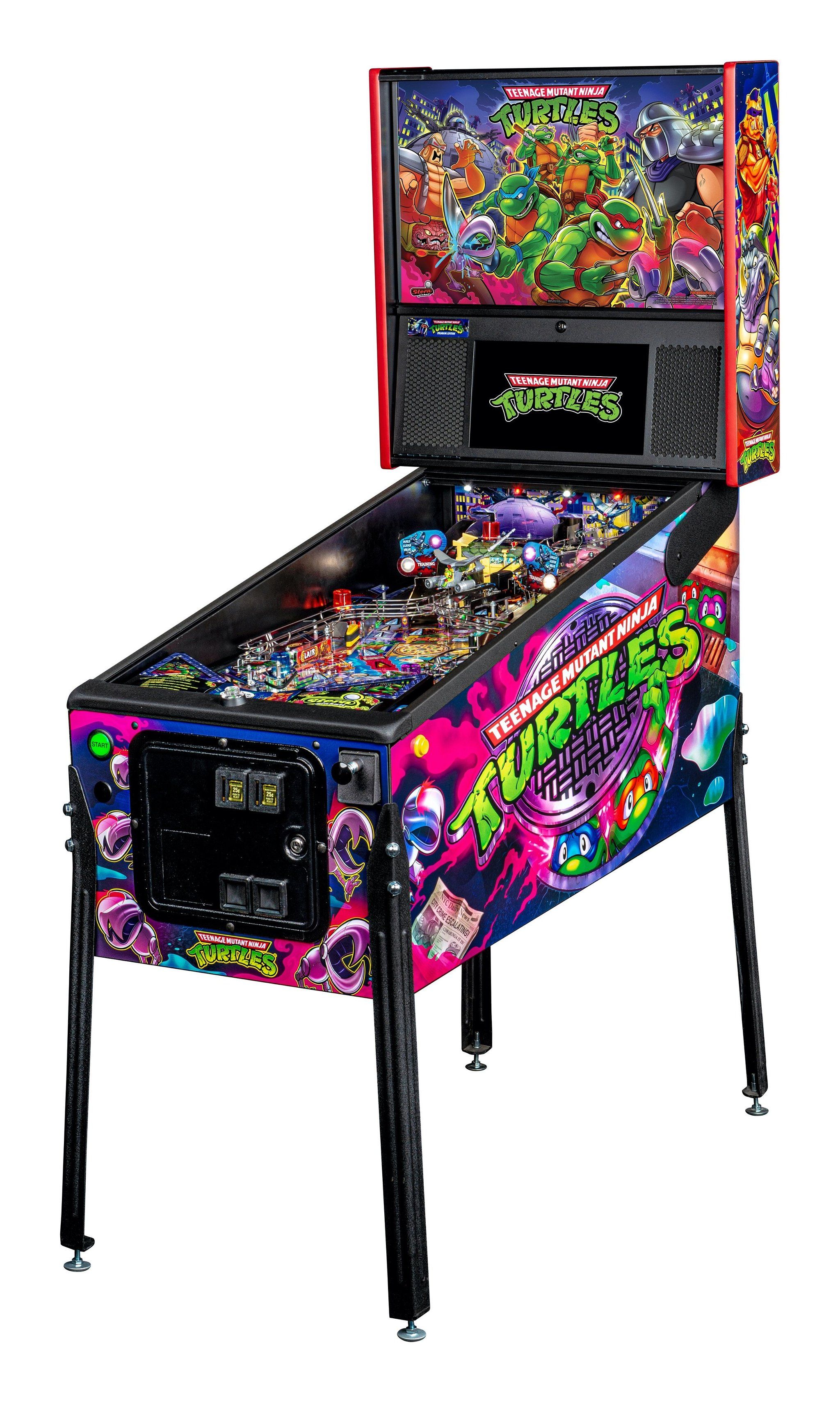 | Teenage Mutant Ninja Turtles Premium Stern Pinball (2020) | Leonardo, Donatello, Raphael and Michelangelo are the Teenage Mutant Ninja Turtles, trained in the art of ninjutsu by their wise rat sensei, Master Splinter. Is New York City ready for these radical reptile brothers? With a sick sewer lair and tough friends like April O’Neil and Casey Jones, the Turtles are about to face evils more dangerous and pizza more delicious than anything they could have ever imagined. In this pinball adventure players will go to battle as the Turtles fight villains like Shredder, the Krang and loads of super-powerful mutants, to become the heroes they were destined to be, and have loads of fun along the way! “Teenage Mutant Ninja Turtles began as a comic book, morphed into a hit animated show, and has grown into a beloved and iconic global pop culture phenomenon. We have worked directly with Nickelodeon to bring these heroes in a half-shell into the pinball dimension. This game has pure pinball power,” said Gary Stern, Chairman and CEO of Stern Pinball, Inc. The Premium model features an interactive custom sculpted Turtles Van, equipped to lock up to 4 balls inside with a mechanical opening/closing side door, ready to unleash multiball havoc upon players. These models also feature the iconic TMNT Glider, a custom-sculpted, player-controlled diverter assembly stationed above both ramps, giving players the ability to control and transport the ball to the flipper of their choice. In addition, a custom-sculpted mechanical Krang toy hovers over the pop bumpers, jumping up and down while taunting players throughout game action. The Premium model features distinct hand-drawn art in addition to a high speed magnetic spinning pizza disc capable of holding and throwing 3 balls during pizza multiball mayhem. The original 1987 theme music complements the action with custom video scenes and events created exclusively for this pinball experience. All models include 3 flippers, 3 high speed ramps, and a hidden ninja training ball lock area. | ||
 | Uncanny X-Men Pro Stern (2024) | Stern Pinball’s The Uncanny X-Men pinball machine brings together the iconic Marvel superhero team in a thrilling, fast-paced gaming experience. Featuring characters like Wolverine, Cyclops, and Magneto, the game offers dynamic gameplay in familiar X-Men locations, complemented by interactive elements, custom art, and an immersive soundtrack. This pinball adventure is designed to captivate players with exciting mechanics, special features, and the ability to connect with other players globally through Stern’s Insider Connected platform. | ||
| Sport Game | ||||
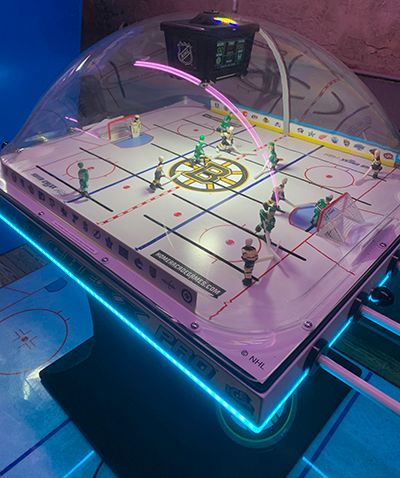 | Bubble Hockey - Bruins vs. Whalers Chexx - ICE (2024) | Classic Bubble Hockey with an LED jumbotron, built in cup holders, and LED accent lights featuring the Boston Bruins vs. the Hartford Whalers. | ||
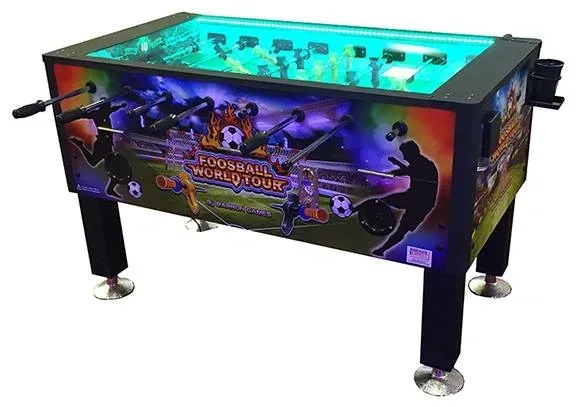 | Foosball Barron Sports | |||
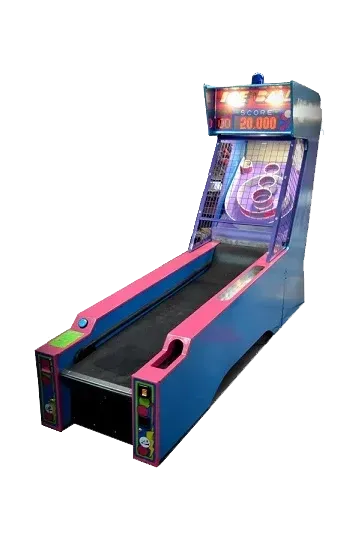 | Ice Ball (2 Lanes) ICE | ICE'S revolutionary version of the traditional alley roller. ICEBALL was designed with the operator in mind at all times. ICEBALL was designed with unprecedented durability and serviceability in every area of the game. It is a 10 ft. alley that has a remarkable number of great features ranging from the electronics which were strategically placed in the front of the game as opposed to the old skeeballs which had all the electronics in the back of the game making access so much more difficult. | ||
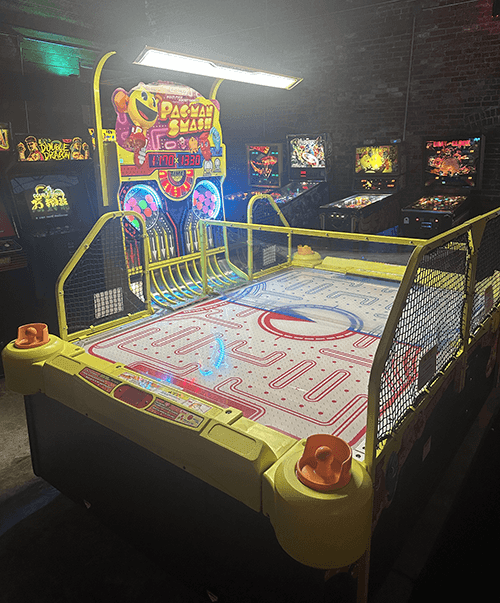 | PAC-MAN Smash Bandai Namco (2012) | If you are looking for a truly innovative concept in air hockey then look no further than Pac-Man Smash by Bandai Namco. This is a game that puts a new twist on the classic arcade game that will leave players wanting to play again while trying to catch their breaths at the same time. | ||
| Gaming Console | ||||
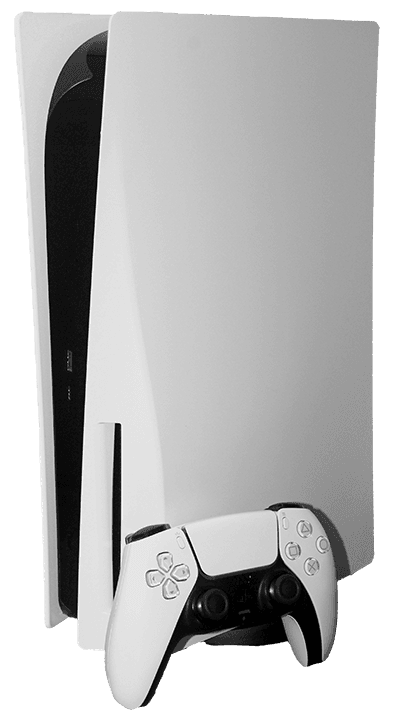 | Playstation 5 Sony (2020) | The PlayStation 5 (PS5) is a home video game console developed by Sony Interactive Entertainment. It was announced as the successor to the PlayStation 4 in April 2019, was launched on November 12, 2020, in Australia, Japan, New Zealand, North America, and South Korea, and was released worldwide a week later. The PS5 is part of the ninth generation of video game consoles, along with Microsoft's Xbox Series X/S consoles, which were released in the same month. | ||
The Ultimate Arcade Experience - Play the Best Games Today
Our collection of arcade games has something for everyone, from timeless classics to the latest hits. With a carefully curated list of the best games, you're guaranteed to have an unforgettable time. Whether you're a seasoned gamer or a newcomer, you'll find endless hours of fun and excitement with our top-rated arcade games.

Aliens: Extermination
Global VR - 2006

All American Football
Leland - 1989

Arctic Thunder
Midway Games - 2000

Area 51
Time Warner Interactive - 1995

Beatmania IIDX
Konami/Bemani - 1999

Centipede
Atari - 1981

Chase HQ
Taito - 1988

Claw Machine
Pinnacle - ICE - 2015

Cruis'n Exotica (2-Player)
Midway - 1999

Daytona USA (2 linked games)
Sega - 1994

Donkey Kong
Nintendo - 1981

Frogger
Konami/Sega/Gremlin - 1981

Galaga
Namco/Midway - 1981

Golden Tee
Incredible Technologies - 1995

Gorf
Atari - 1981

Guitar Hero (Clone Hero)
Srylain Inc. - 2017

Hang On
Sega - 1985

House of the Dead 2
Sega - 1998

Hydro Thunder
Midway - 1999

Mortal Kombat
Midway - 1992

Ms. PAC-MAN (2 games)
Midway - 1982

NFL Blitz
Midway - 1999

Operation Thunderbolt
Taito - 1988

Over Drive
Konami - 1990

Pac-Land
Namco/Midway - 1984

Pac-Man
Namco - 1980

POW: Prisoner of War
SNK - 1988

Punch-Out!!
Nintendo - 1984

Radikal Bikers
Gaelco - 1998

Scramble
Konami/Stern - 1981

Spy Hunter
Bally Midway - 1983

Star Wars Trilogy
Sega - 1998

Star Wars: The Empire Strikes Back
Atari - 1983

StepMania (Dance Dance Revolution Cabinet Upgrade)
Konami/MIT - 2006

Teenage Mutant Ninja Turtles: Turtles in Time
Konami - 1991

Tempest
Atari - 1981

Terminator 2: Judgment Day
Midway - 1991

Virtua Fighter
Sega - 1993

WWF Wrestlefest
Technos - 1991

Deadpool Pro
Stern - 2018

Guns N' Roses Limited Edition
Jersey Jack Pinball - 2021

Star Wars Pinball
Data East - 1992

Star Wars Premium Pinball
Stern Pinball - 2017

Stranger Things Premium
Stern Pinball - 2019

Teenage Mutant Ninja Turtles
Data East - 1991

Teenage Mutant Ninja Turtles Premium
Stern Pinball - 2020

Uncanny X-Men Pro
Stern - 2024

Bubble Hockey - Bruins vs. Whalers
Chexx - ICE - 2024

Foosball
Barron Sports

Ice Ball (2 Lanes)
ICE

PAC-MAN Smash
Bandai Namco - 2012

Playstation 5